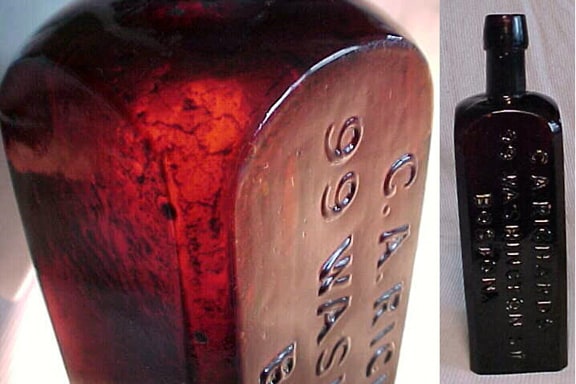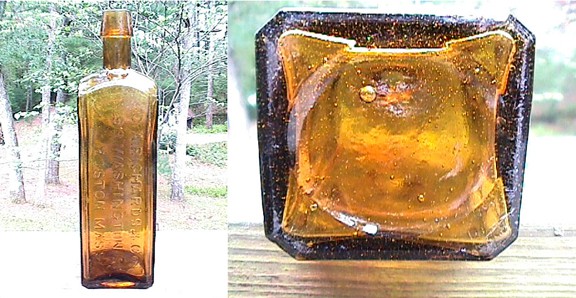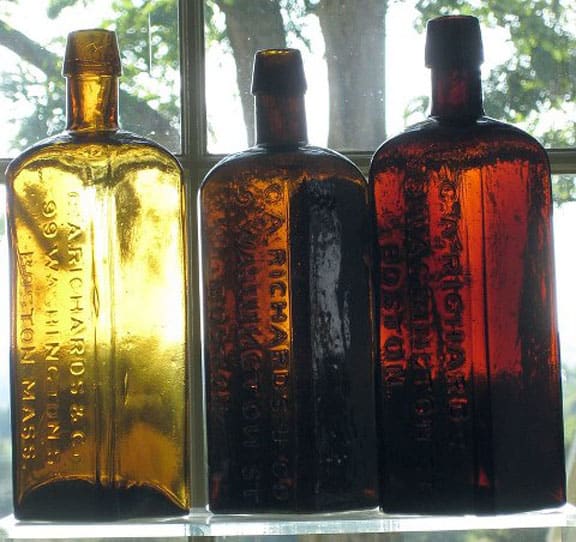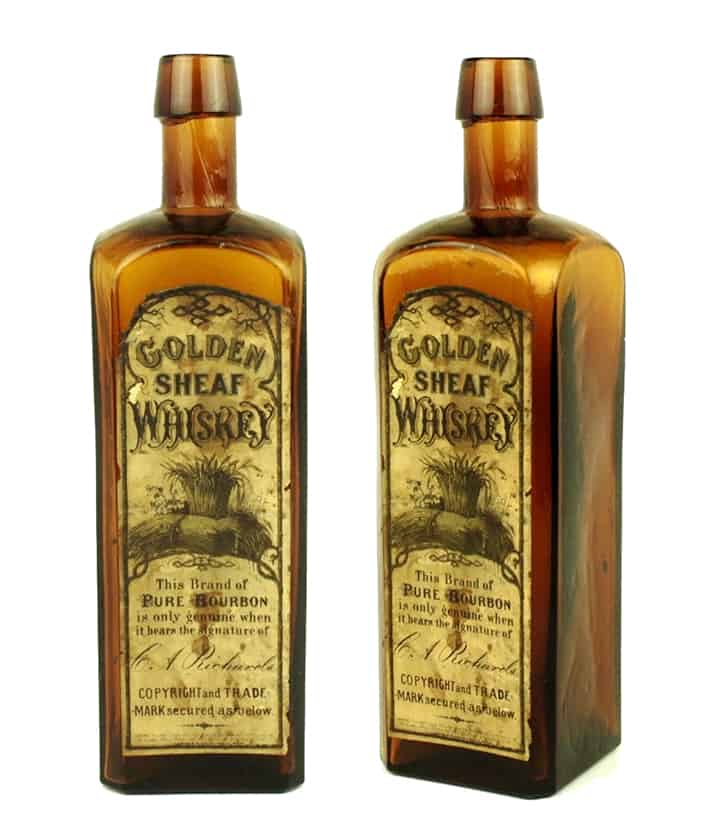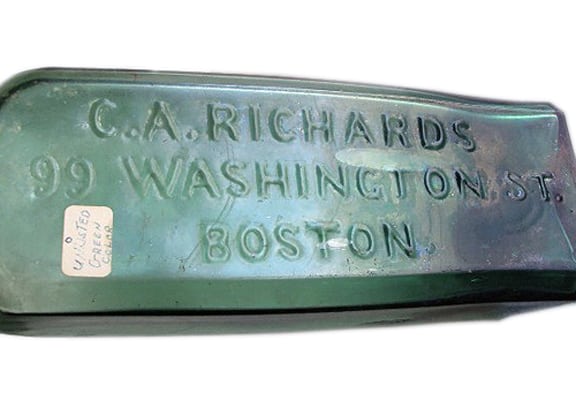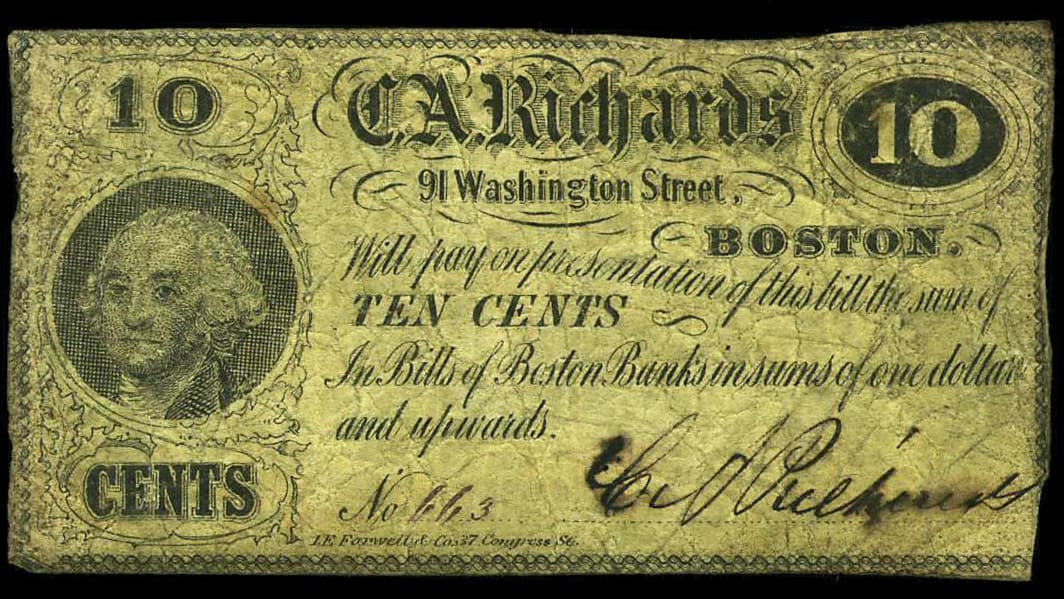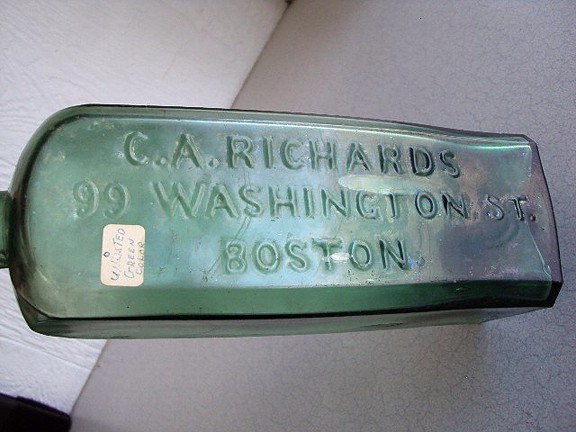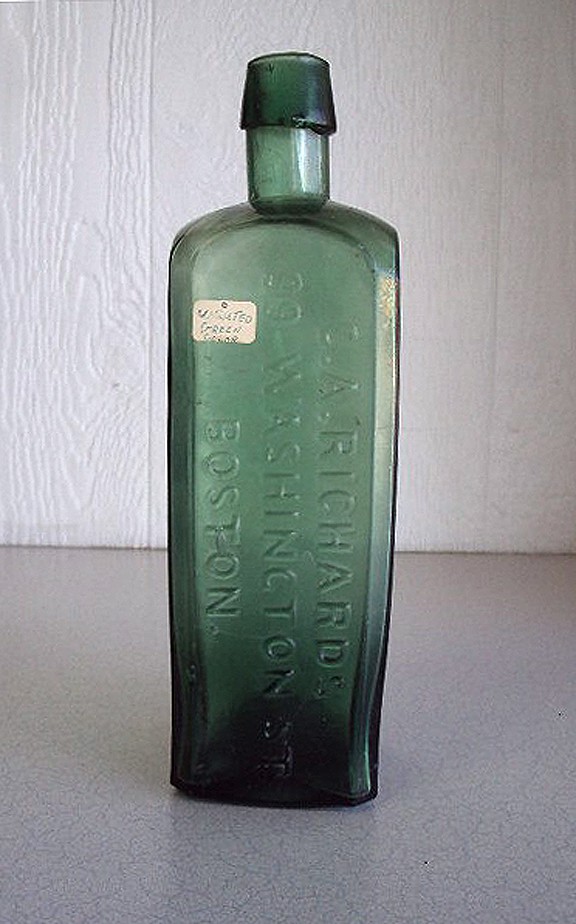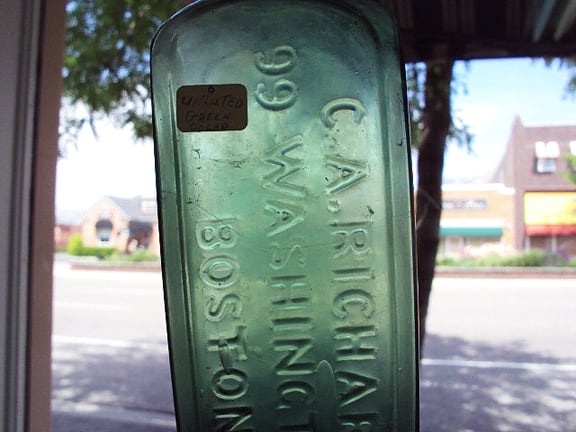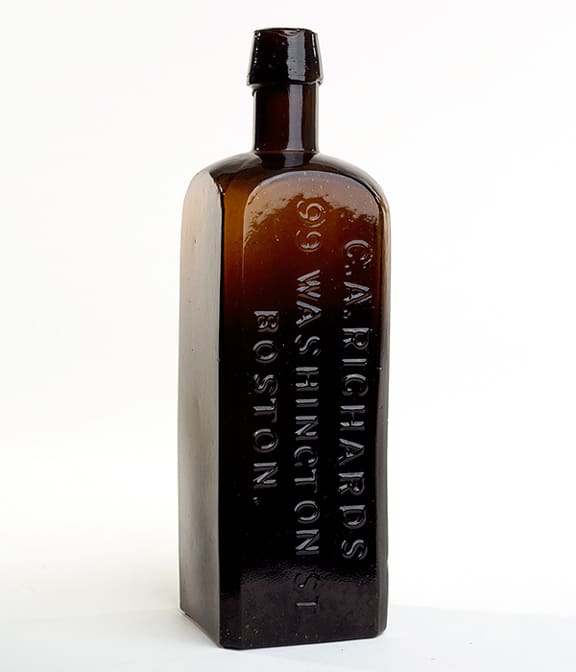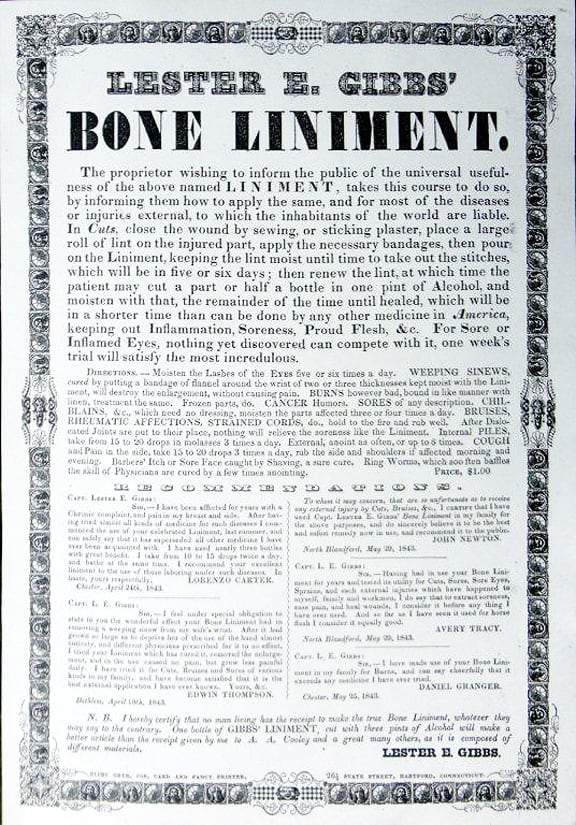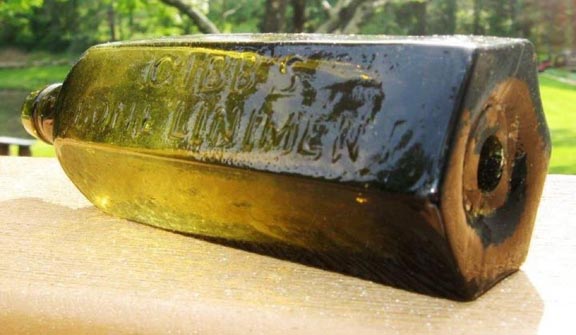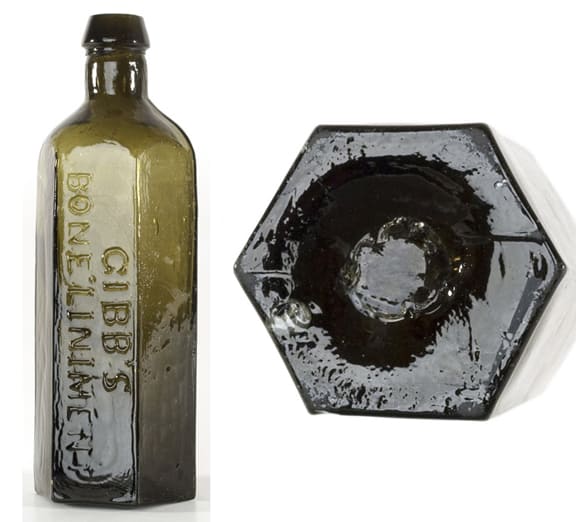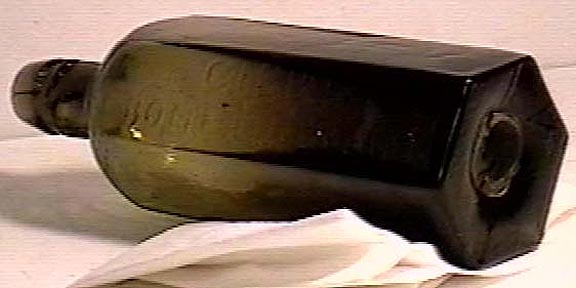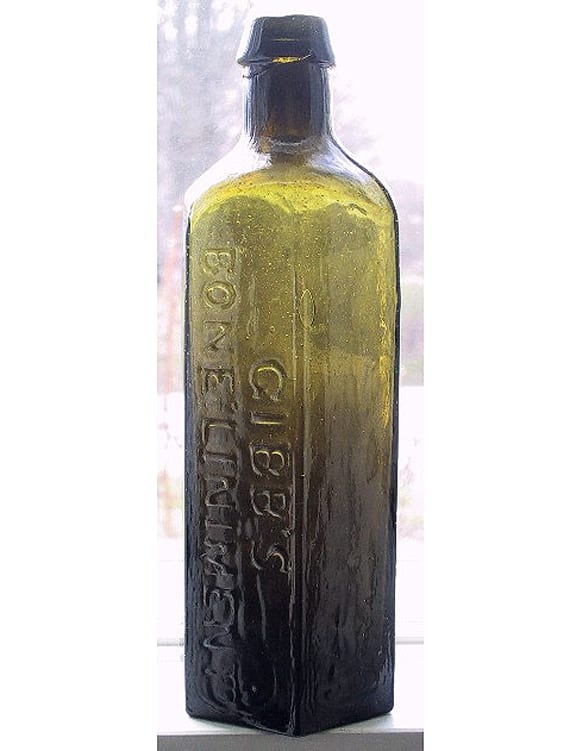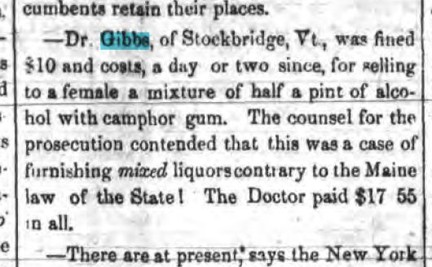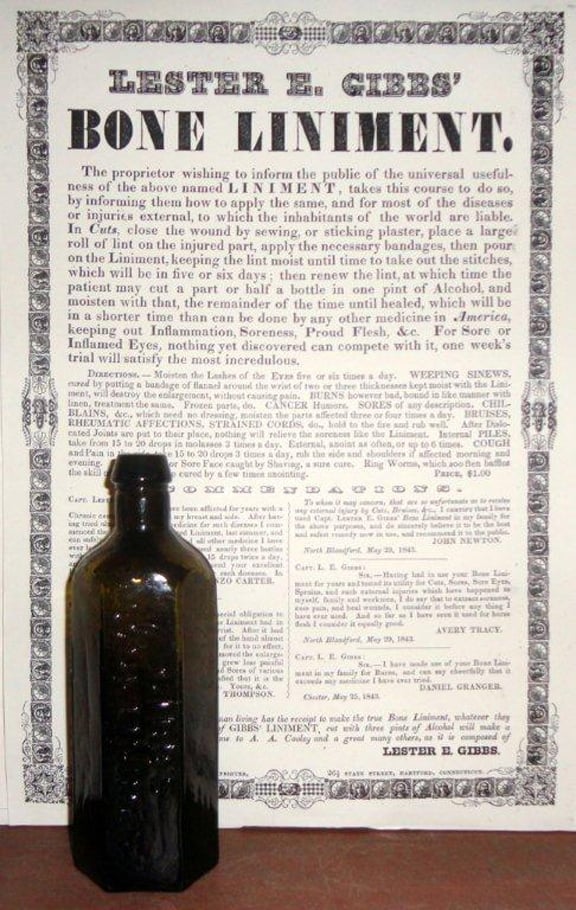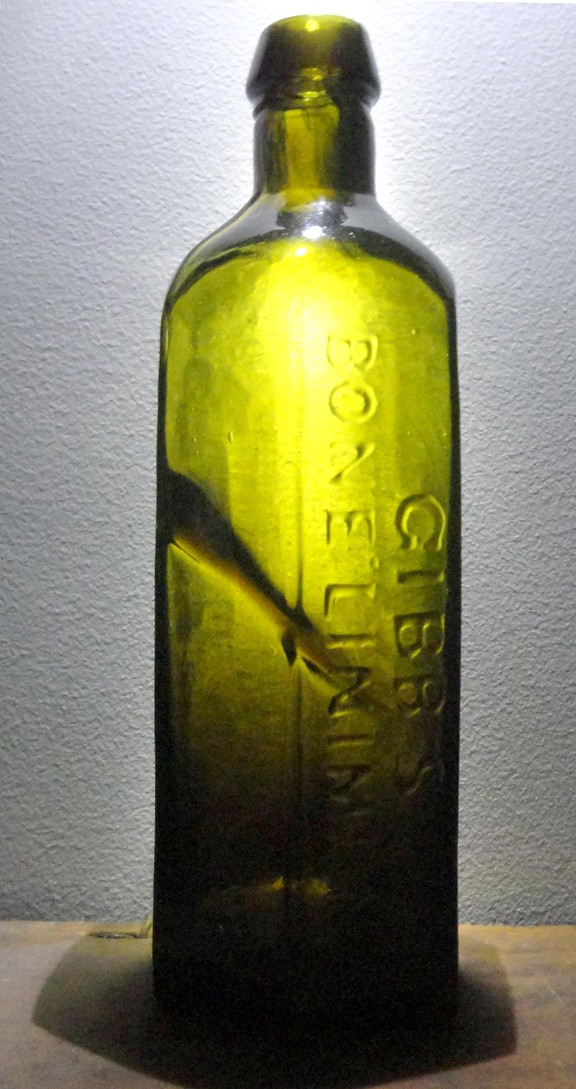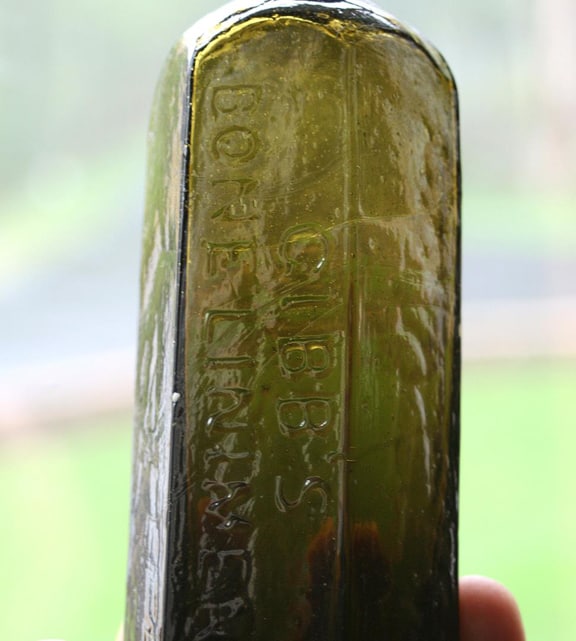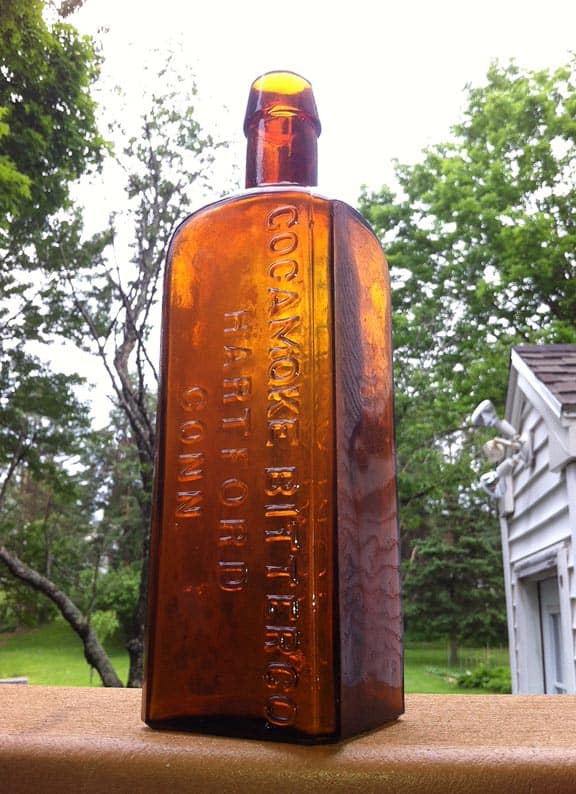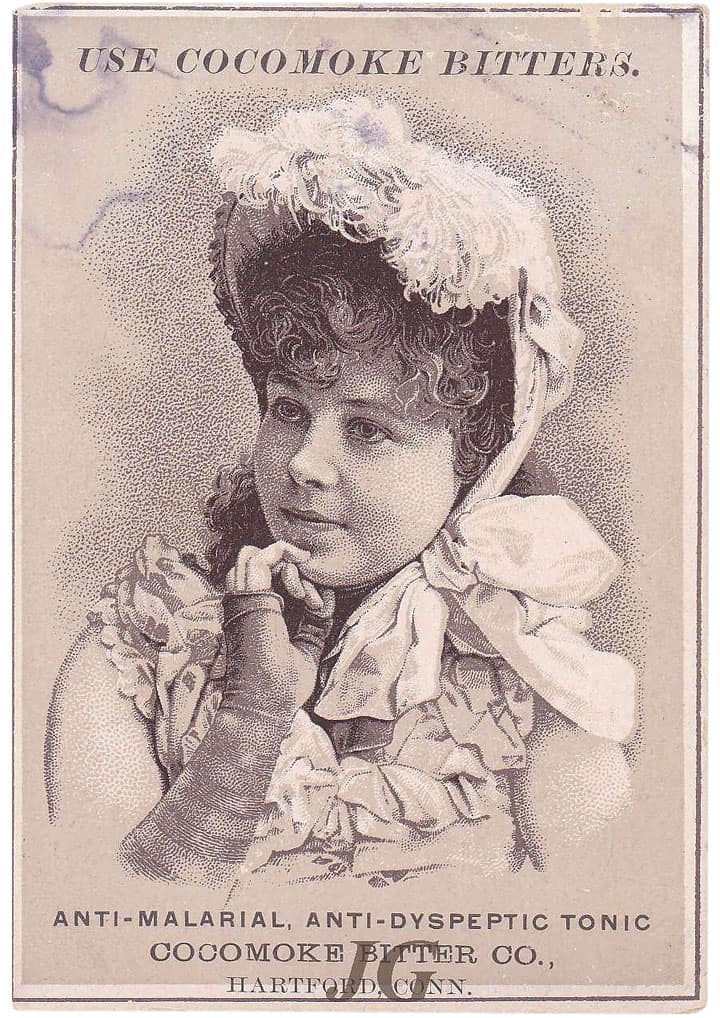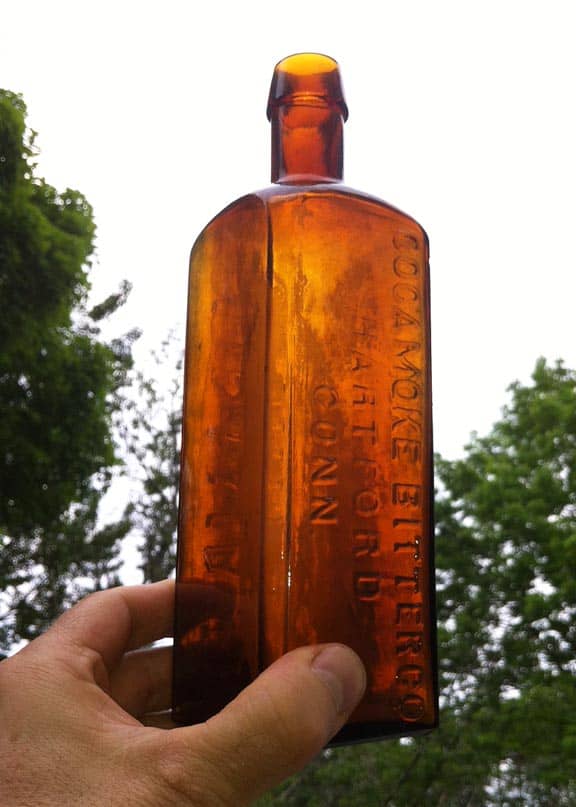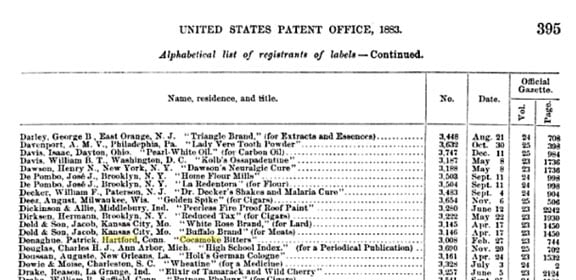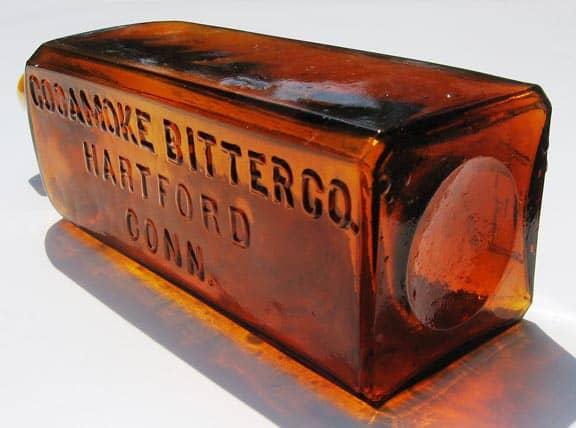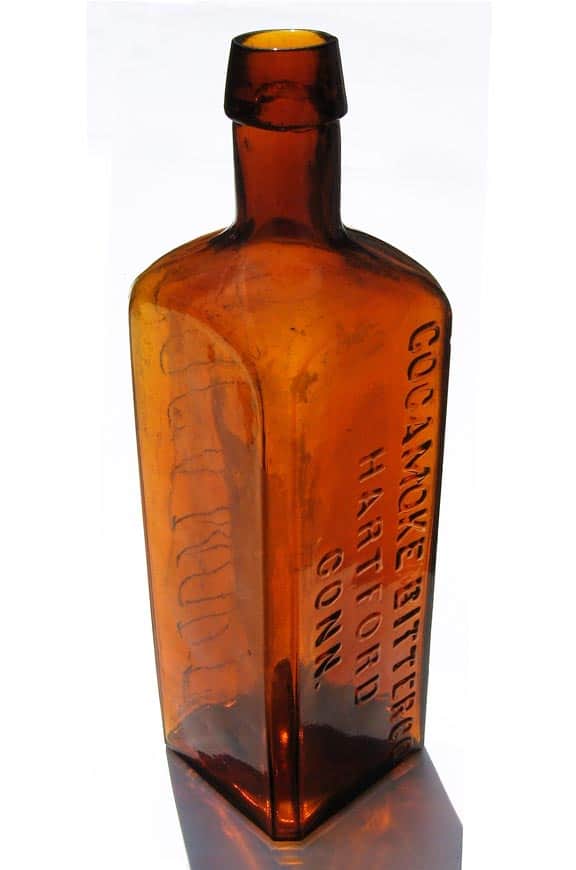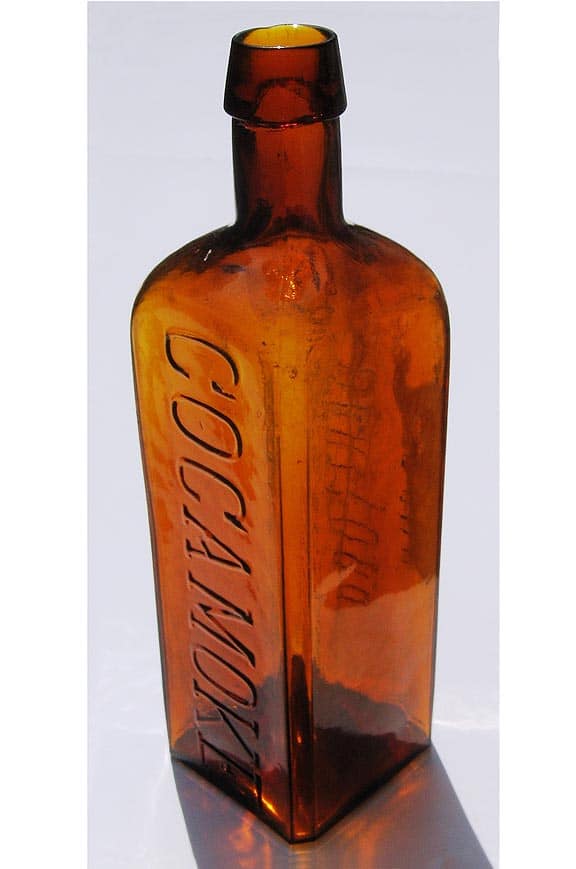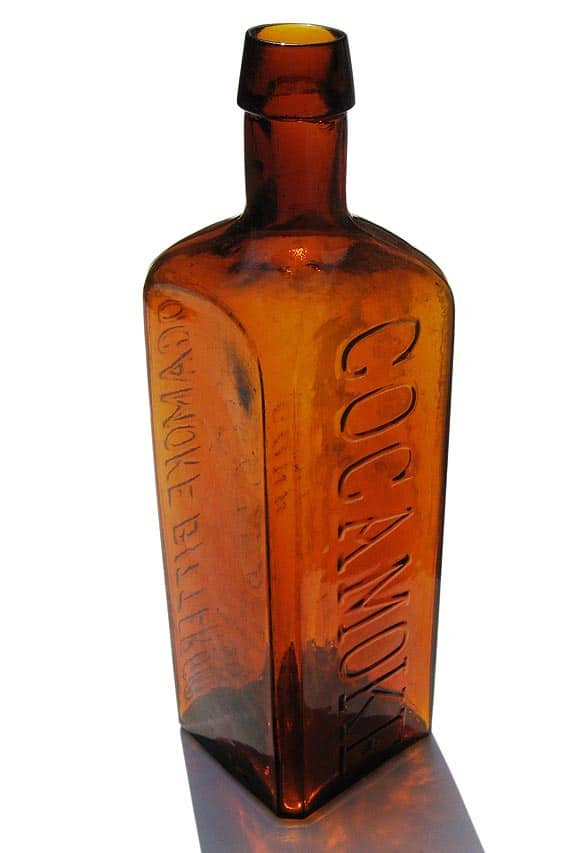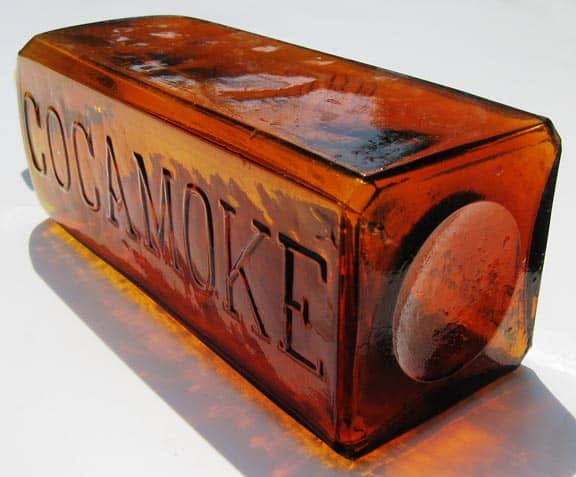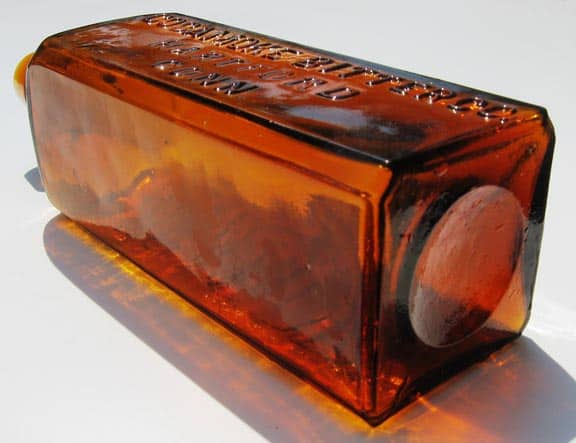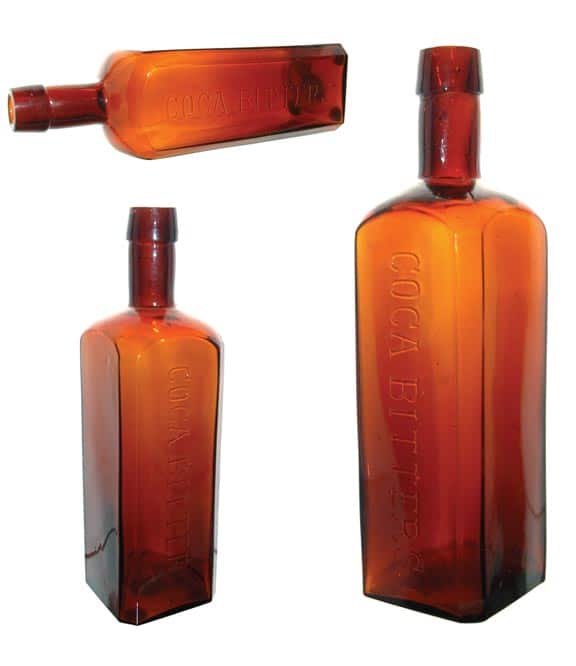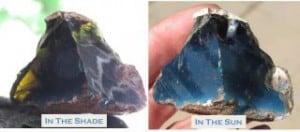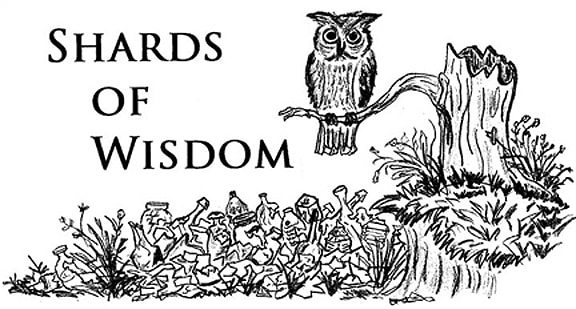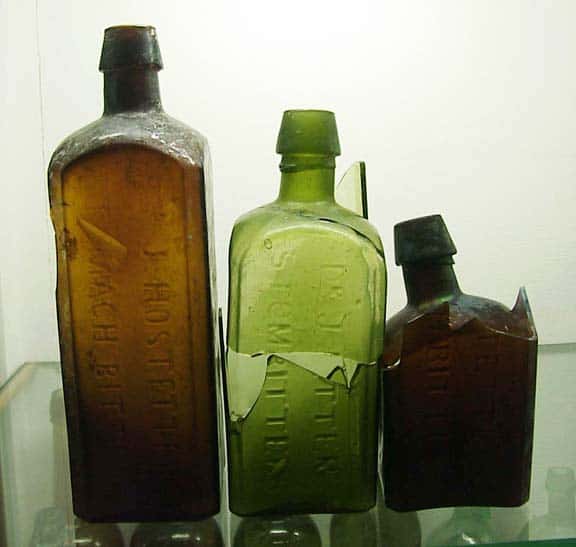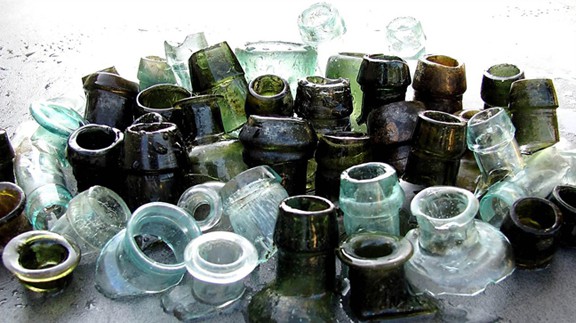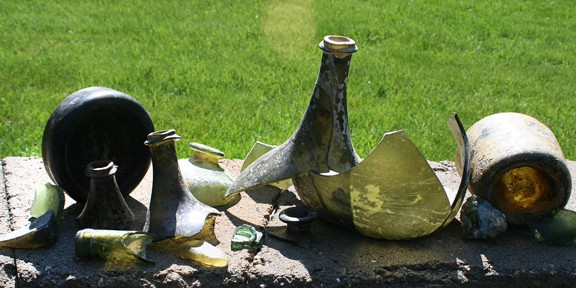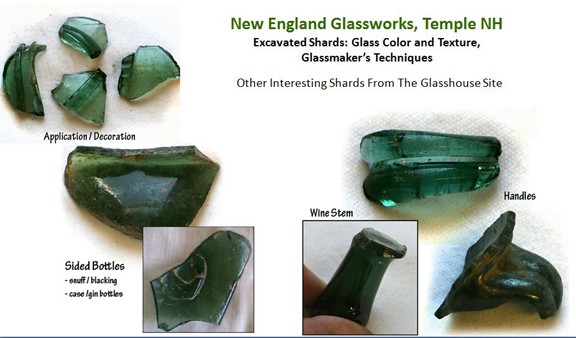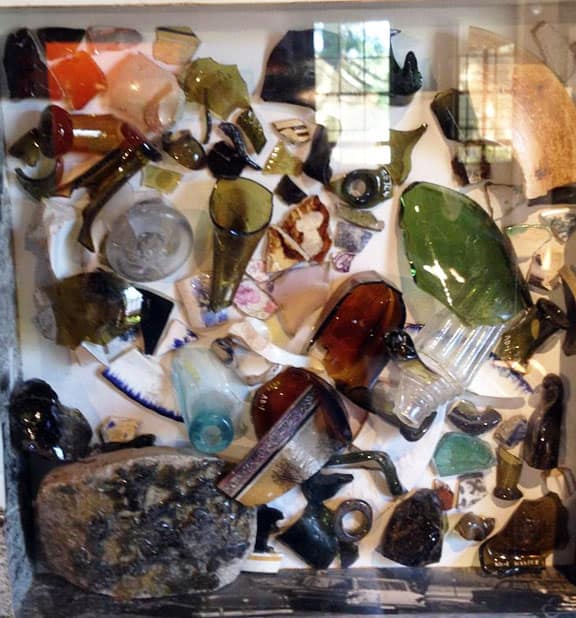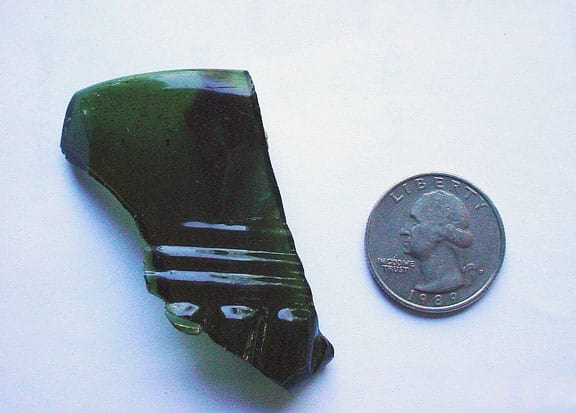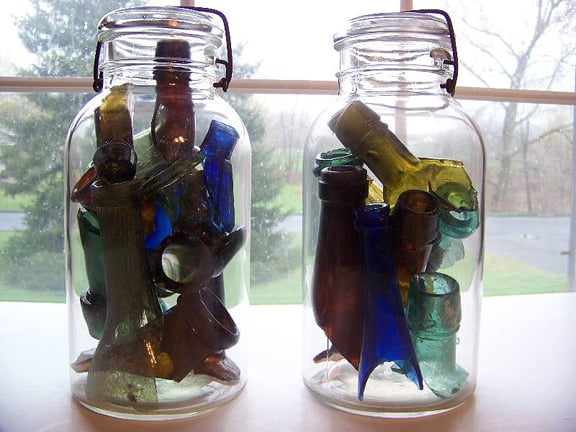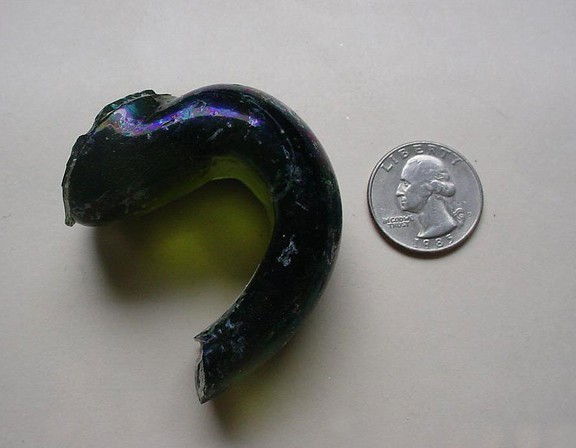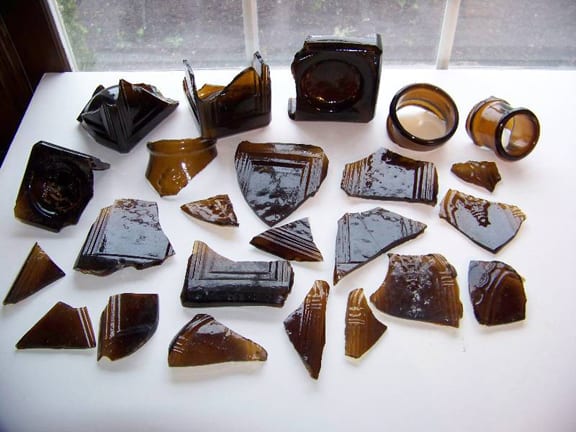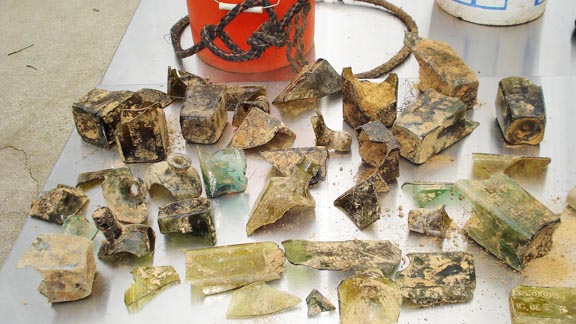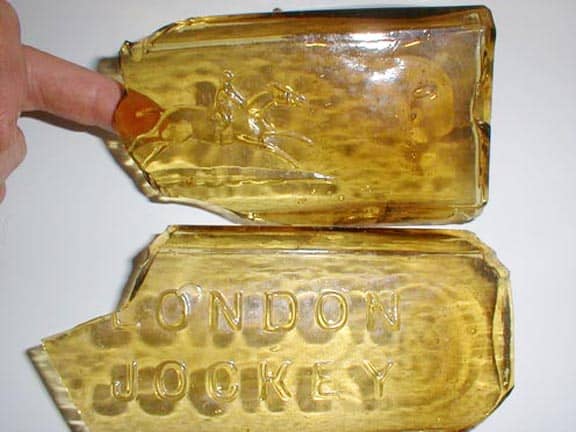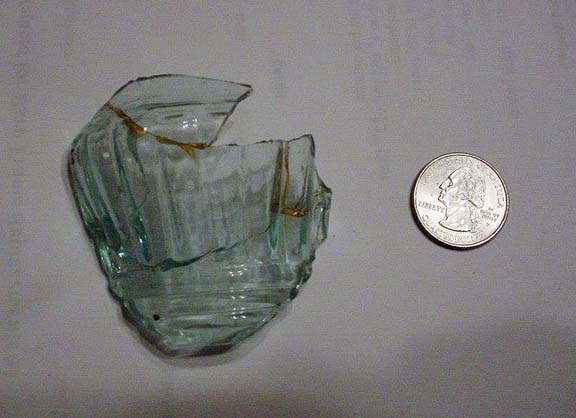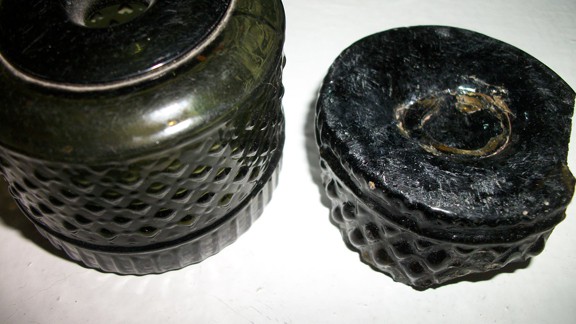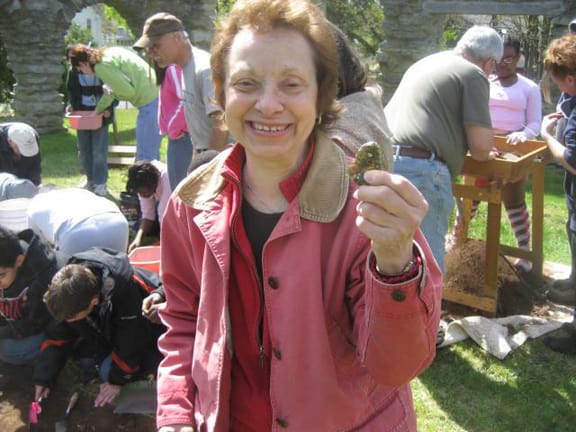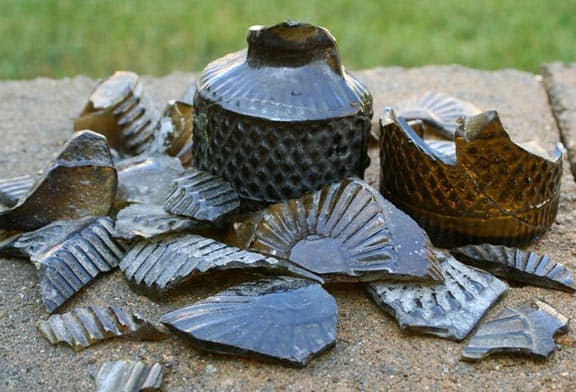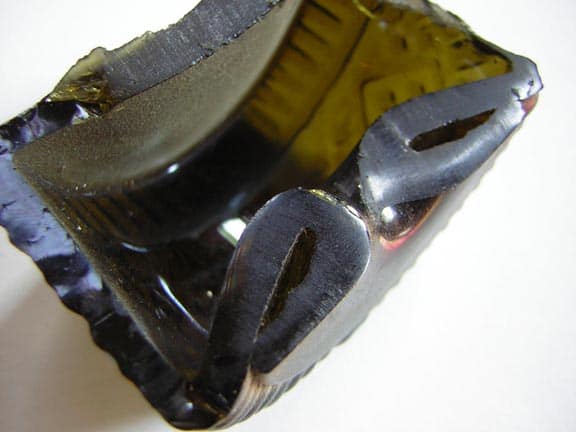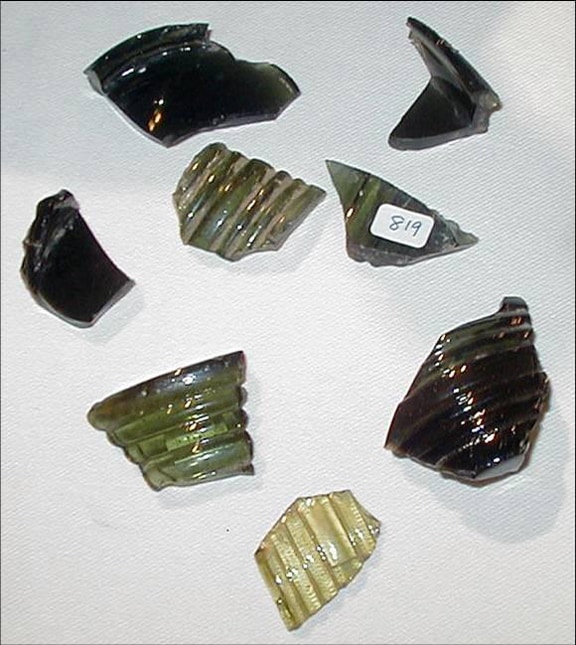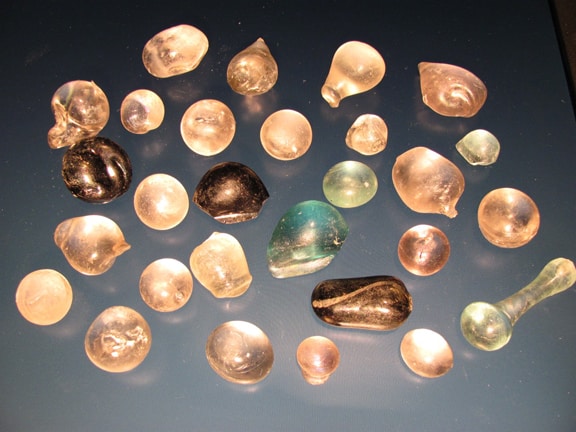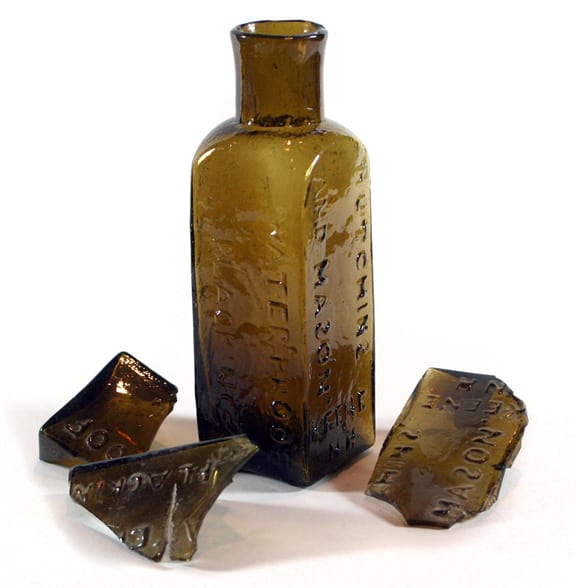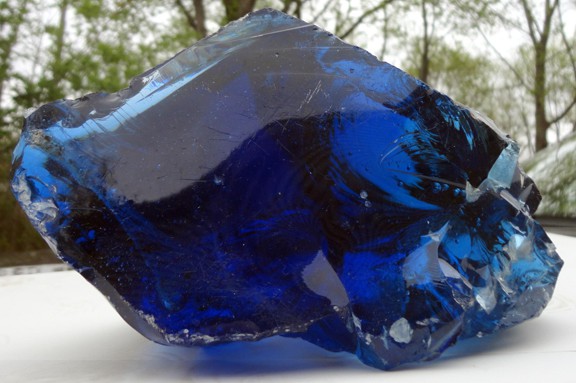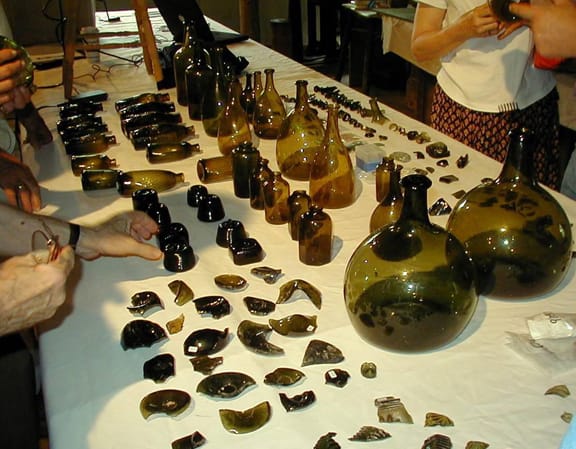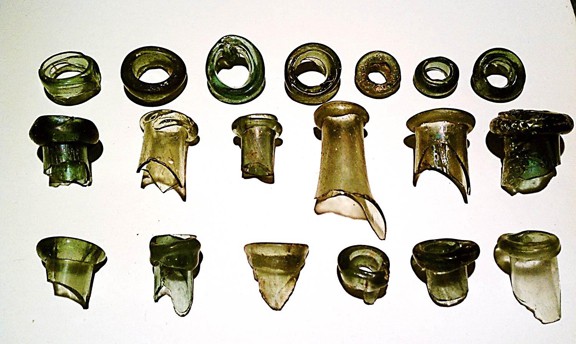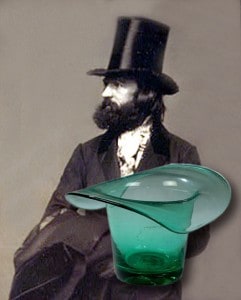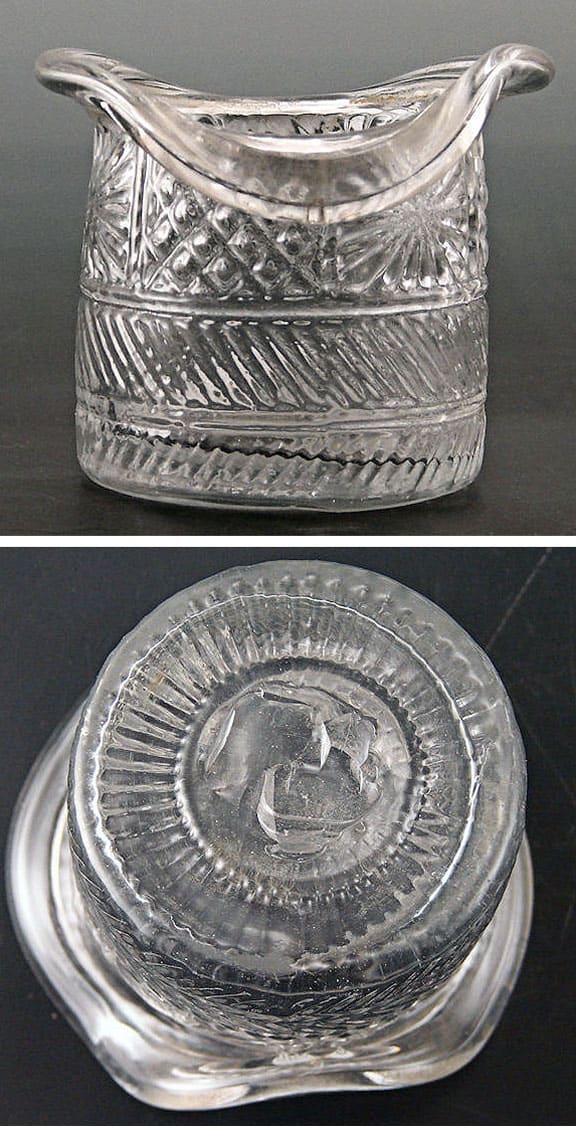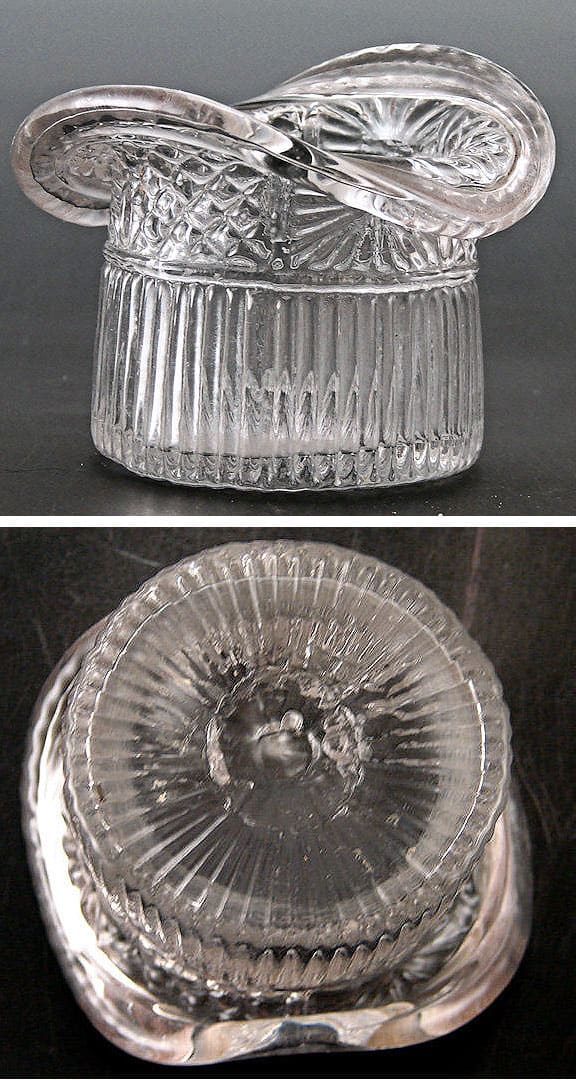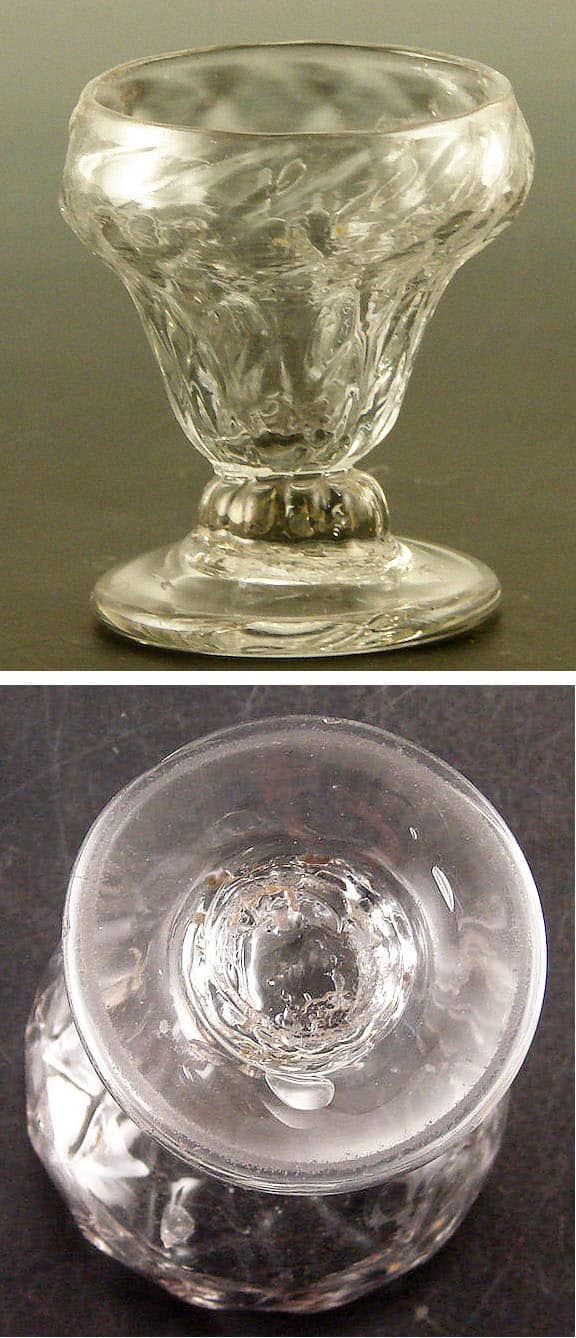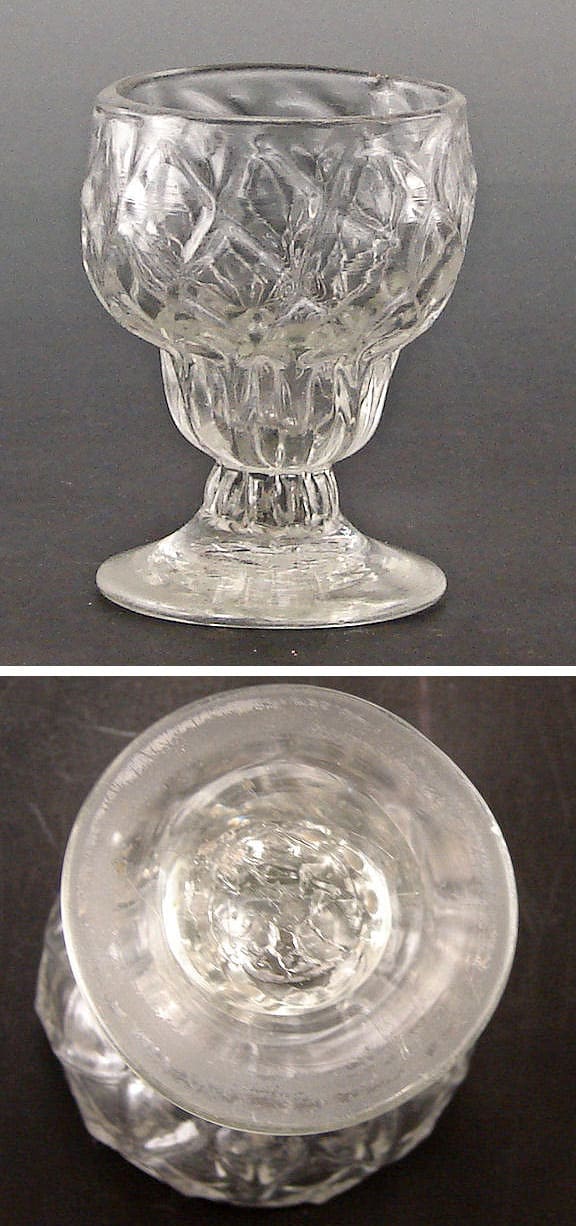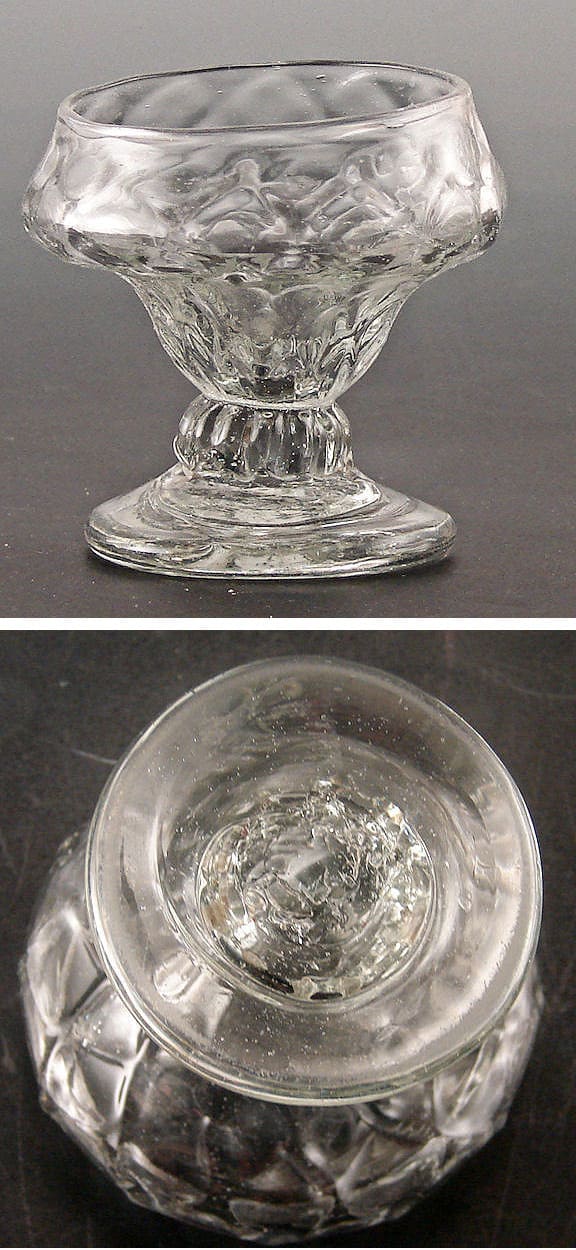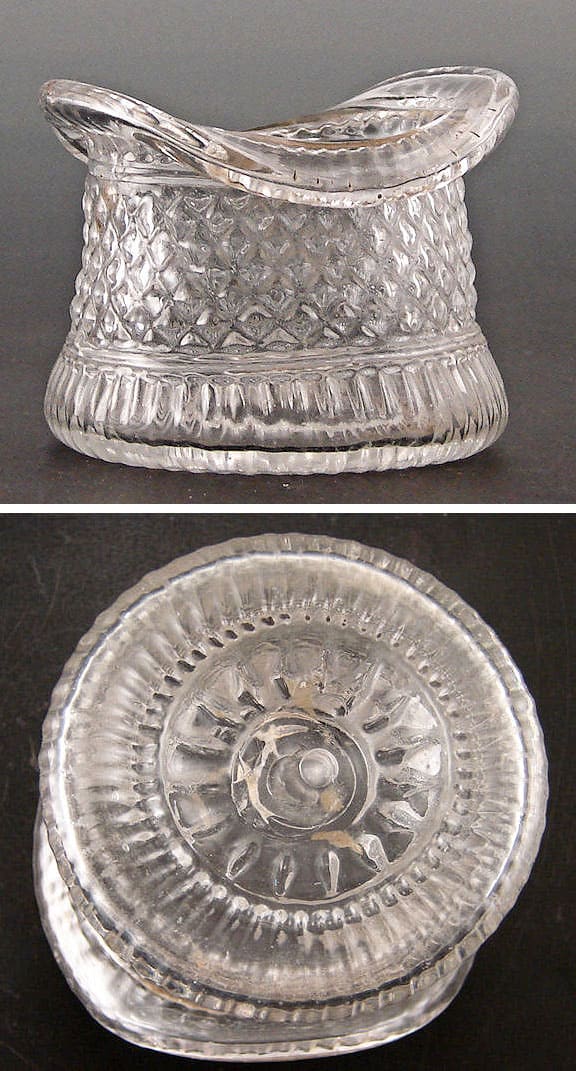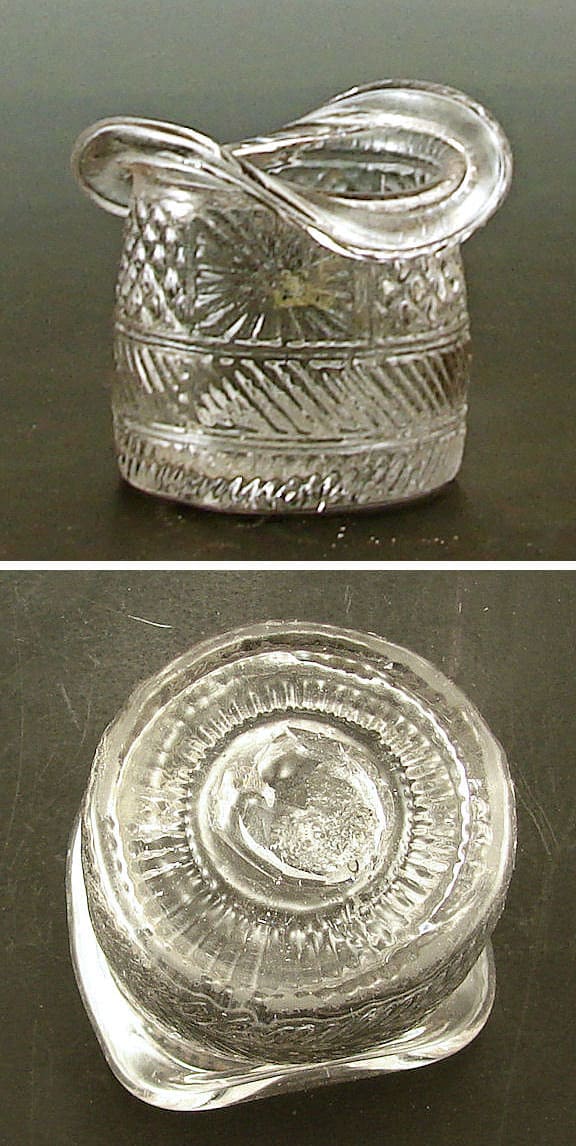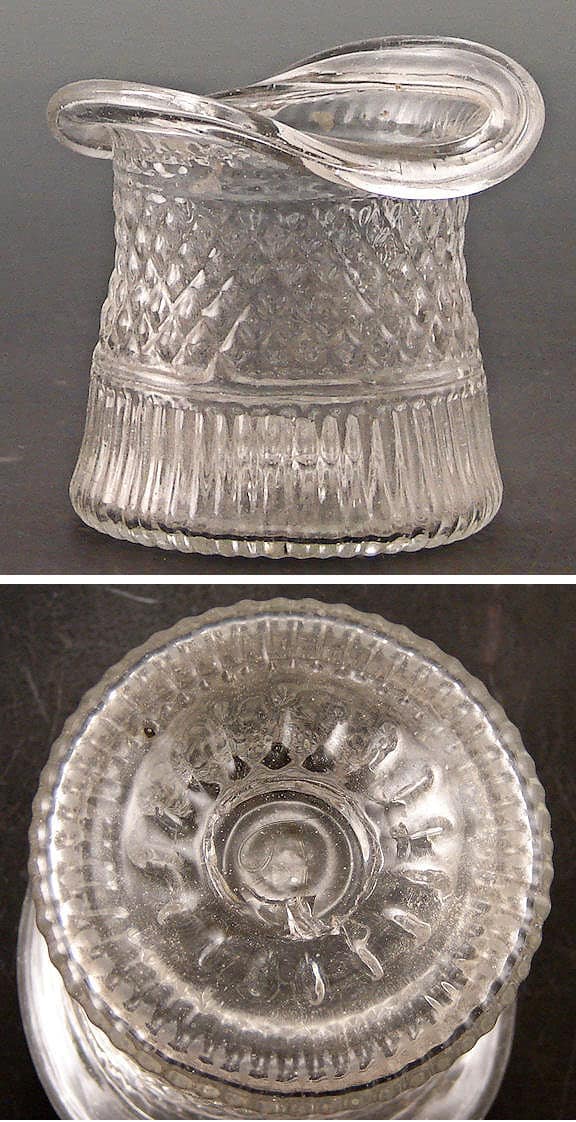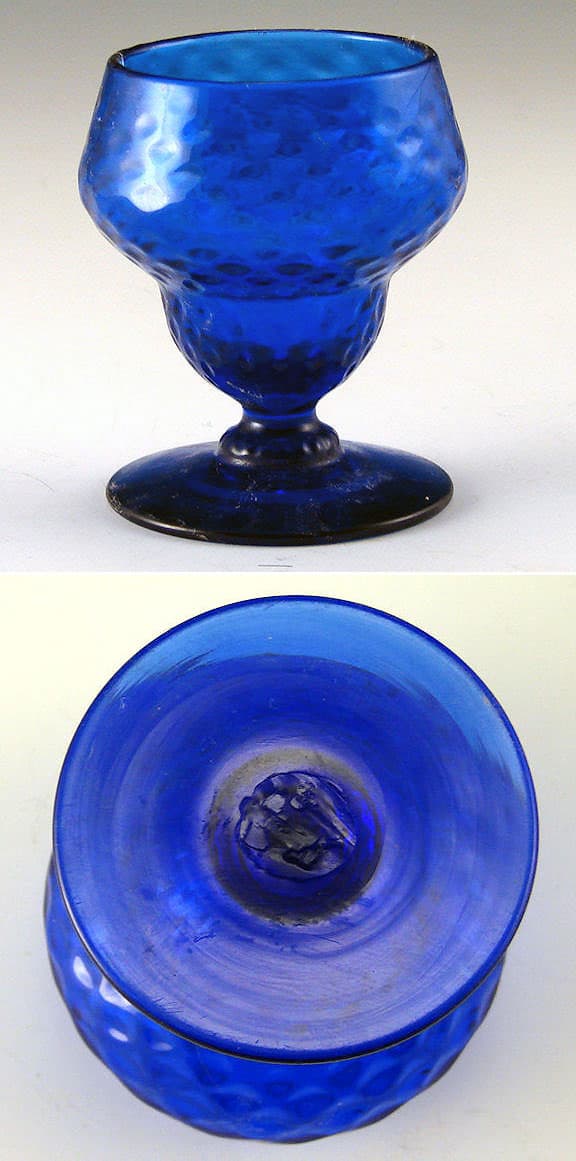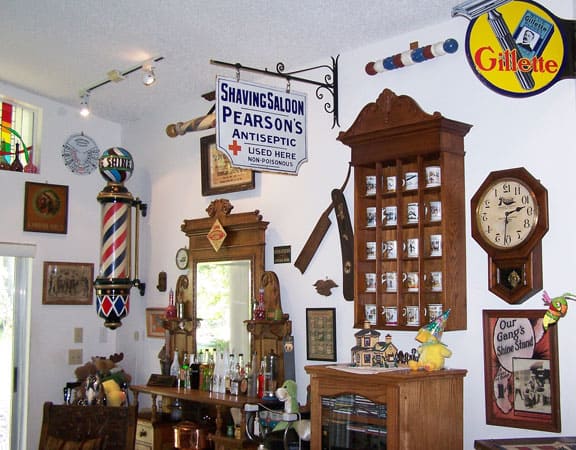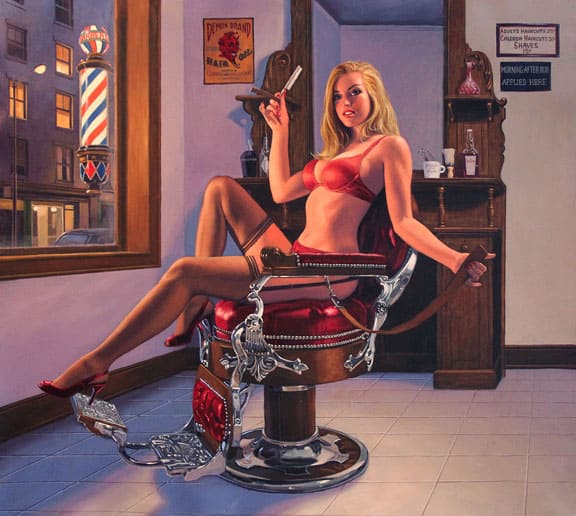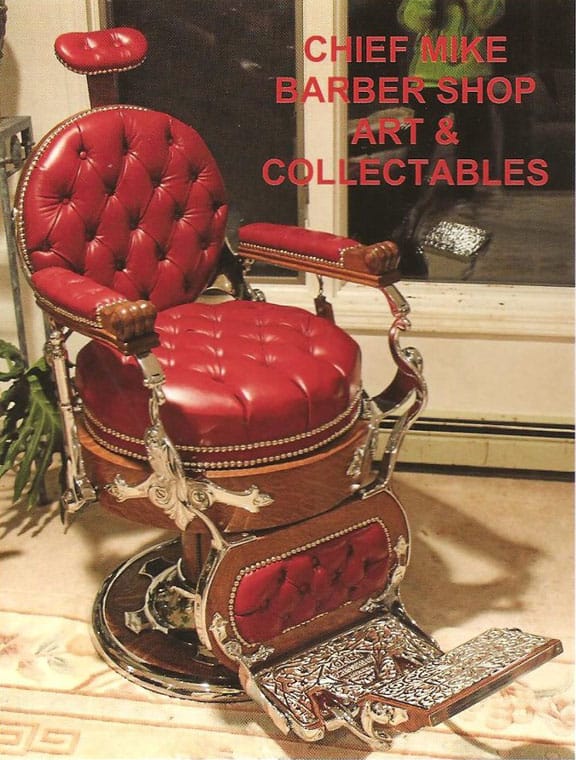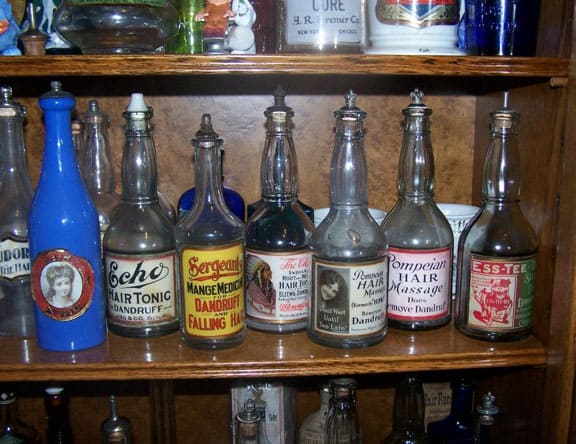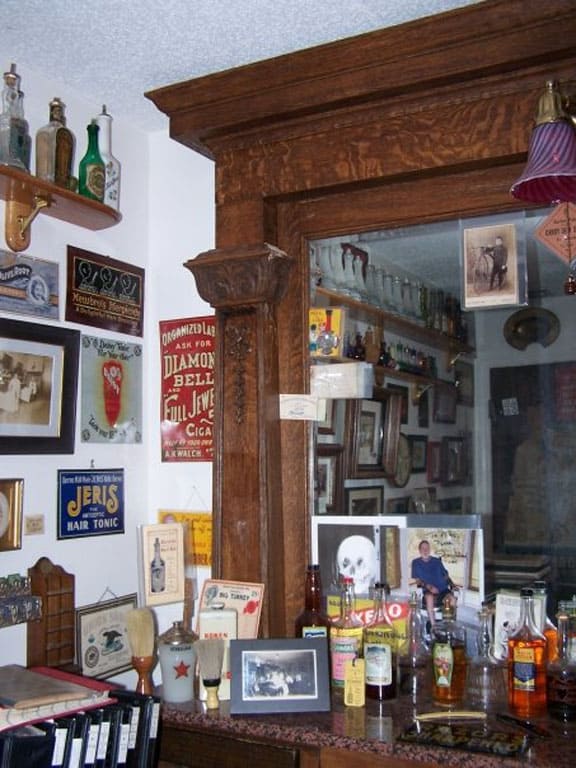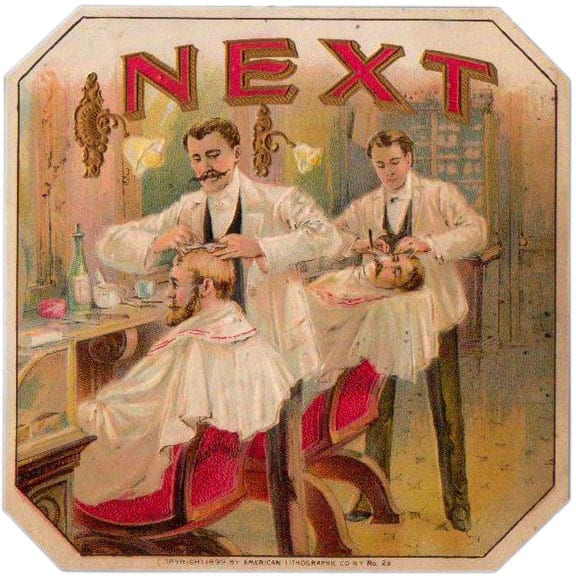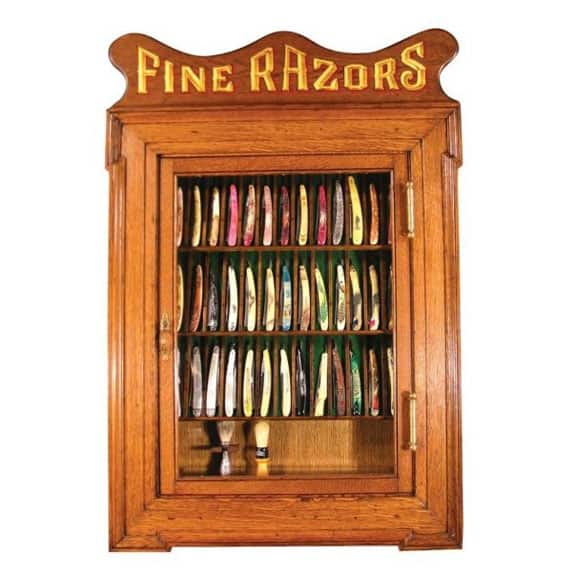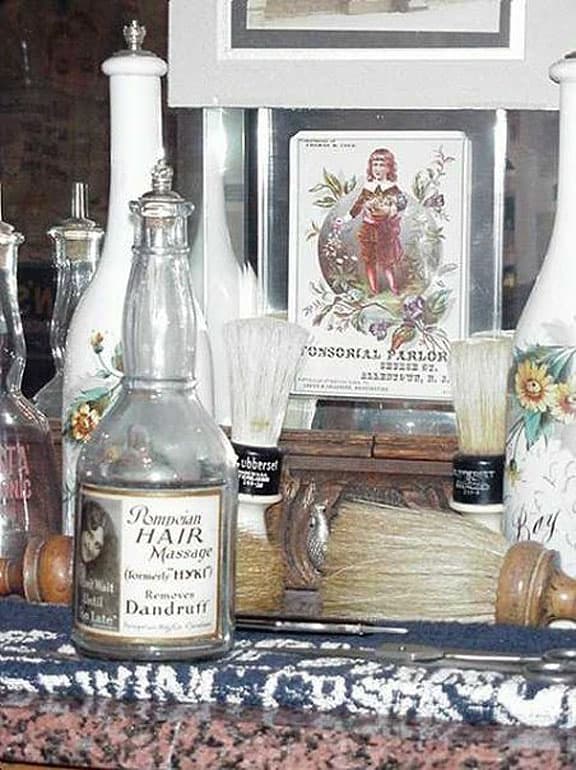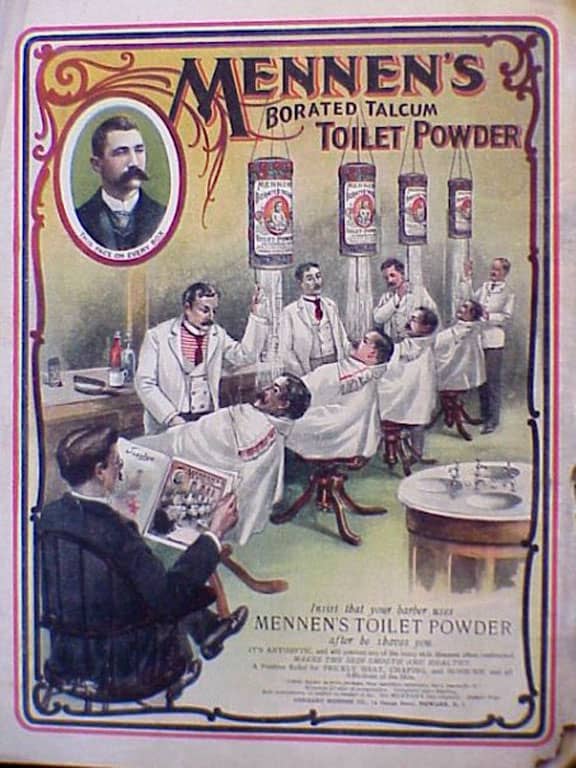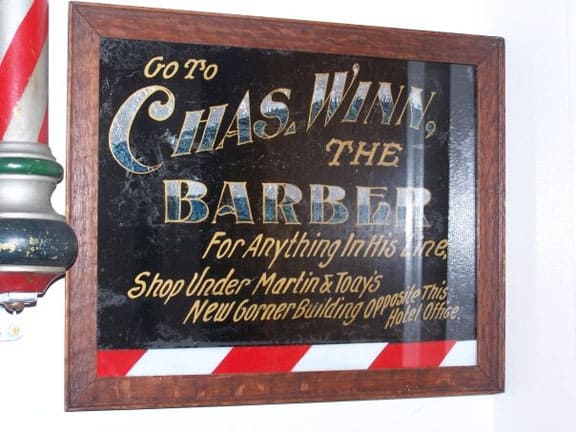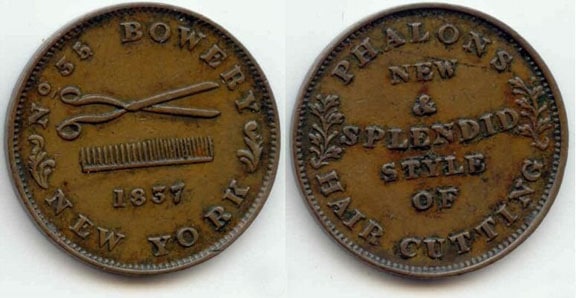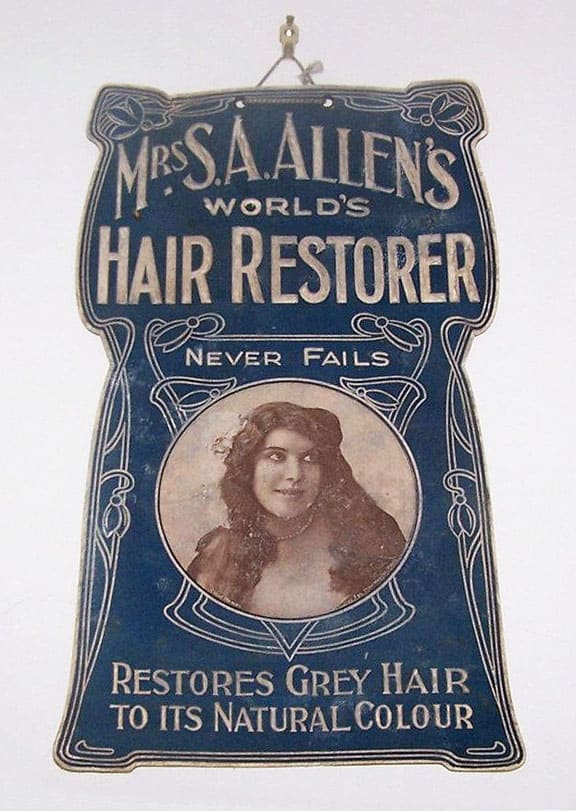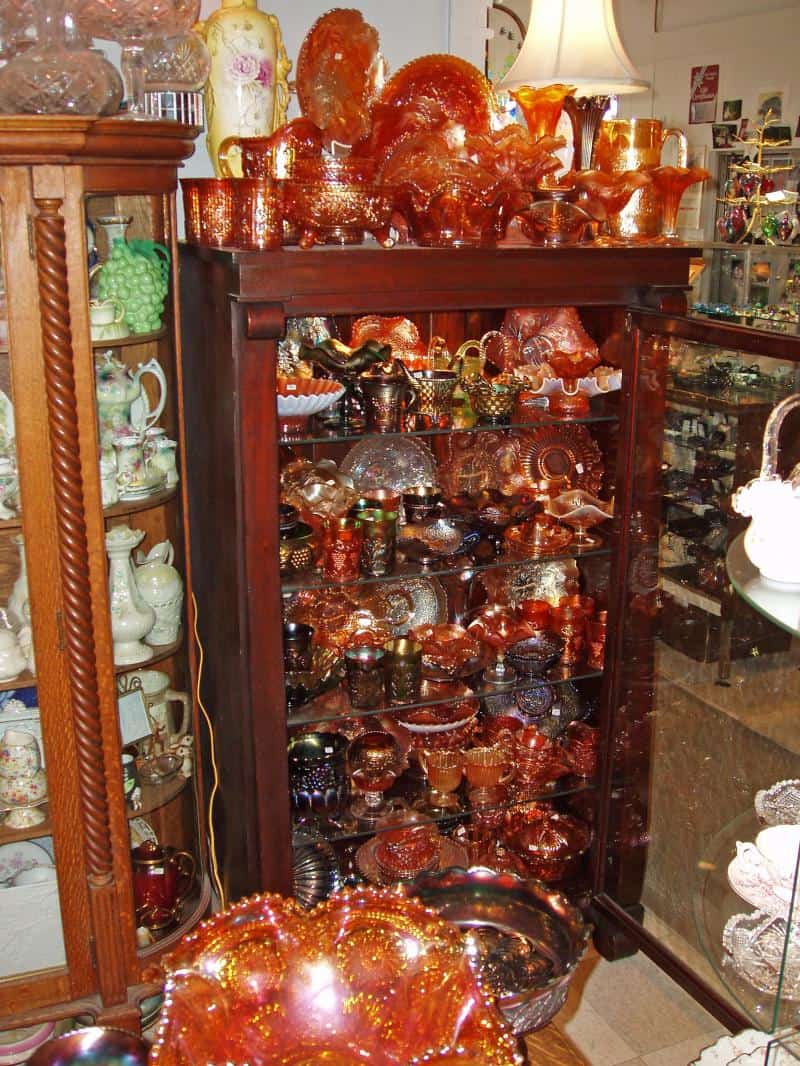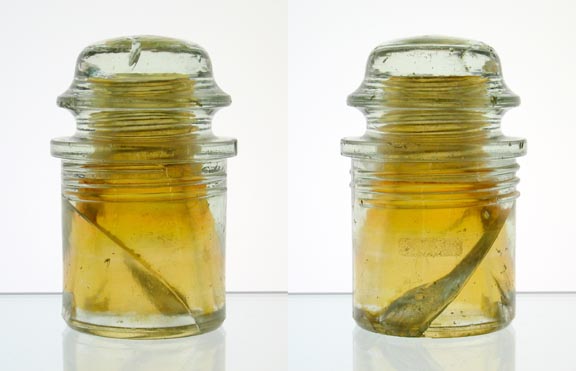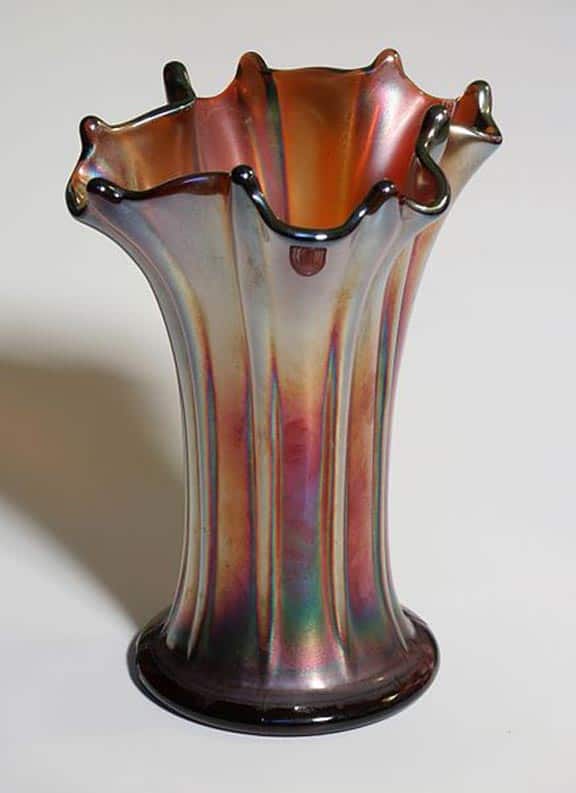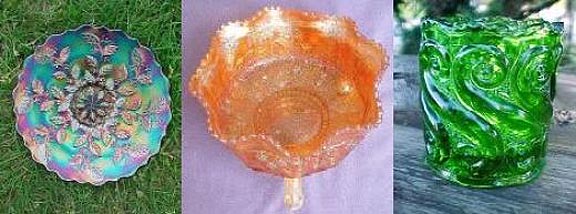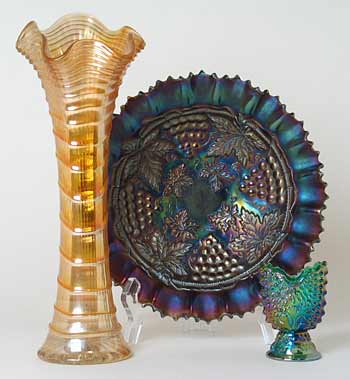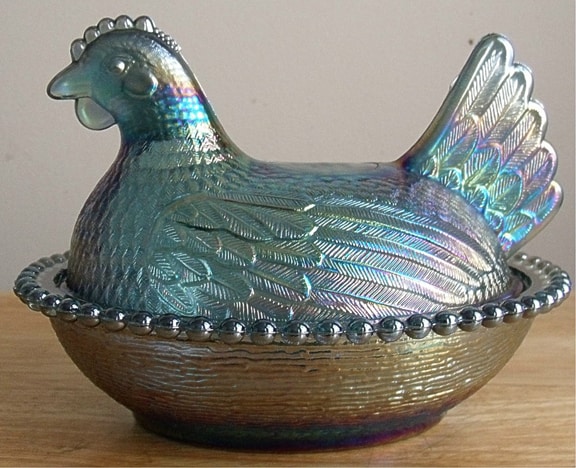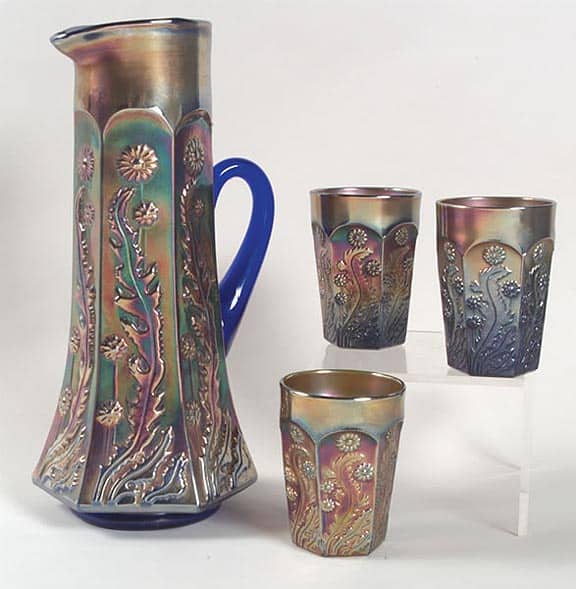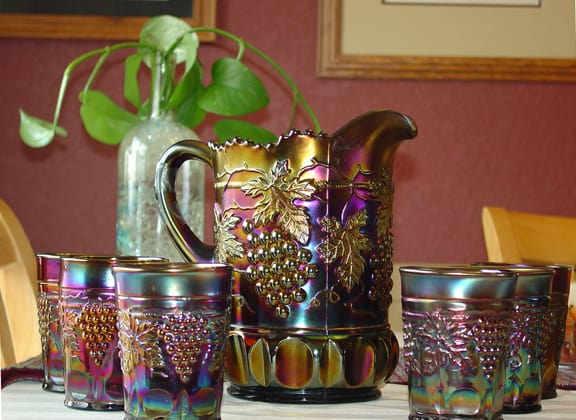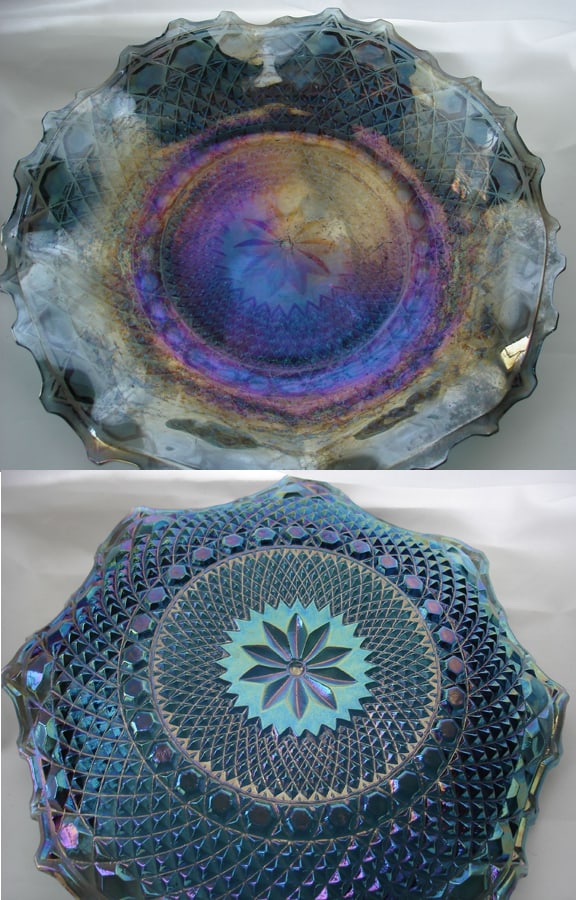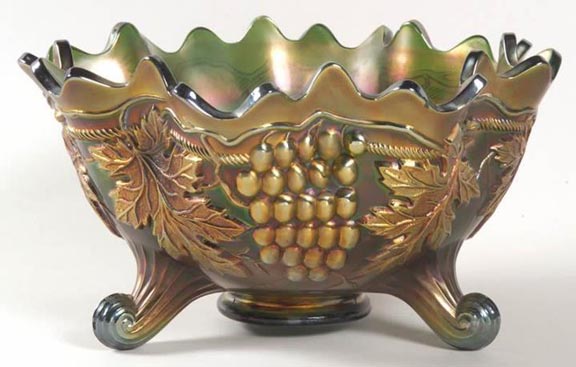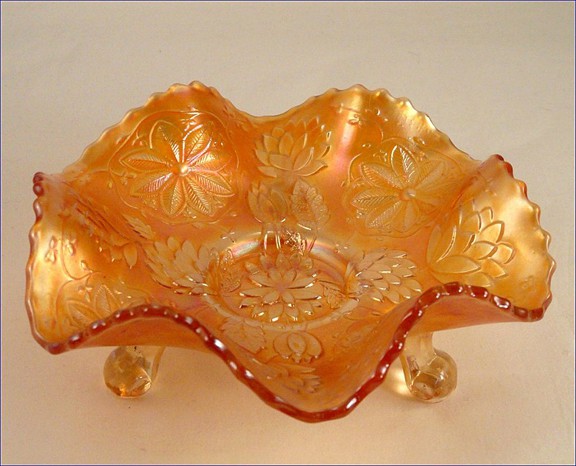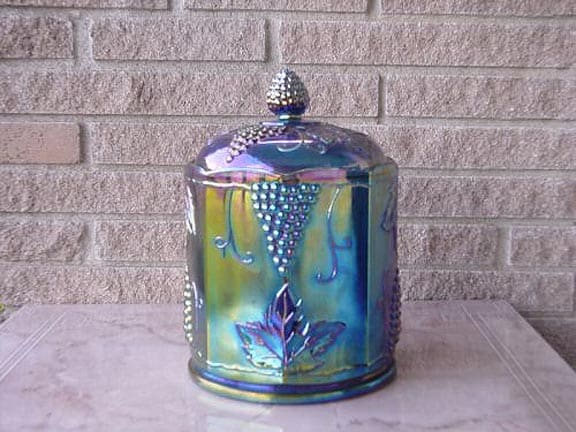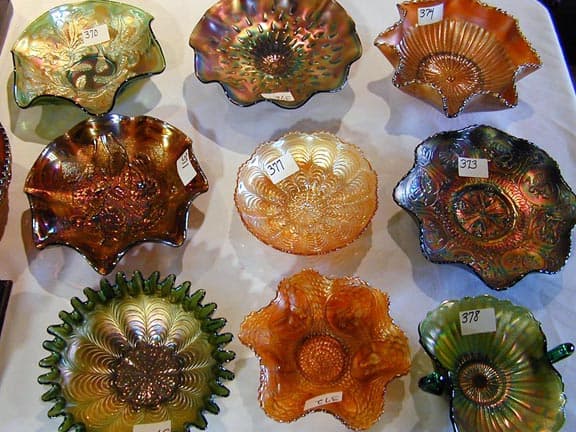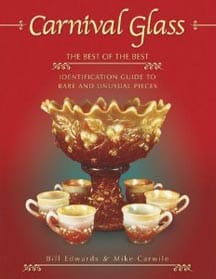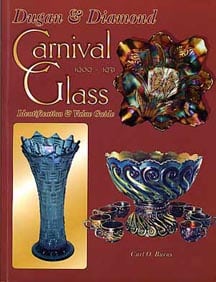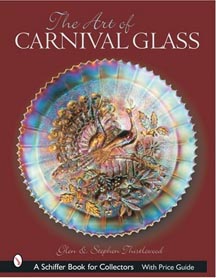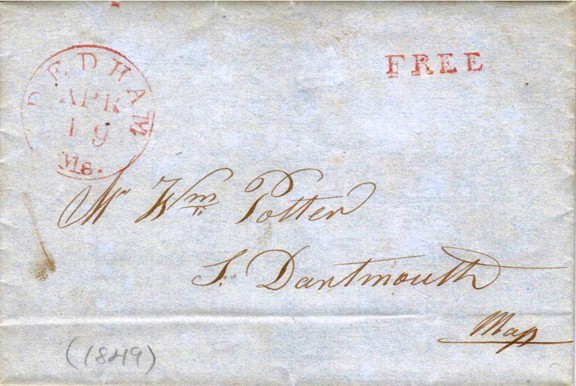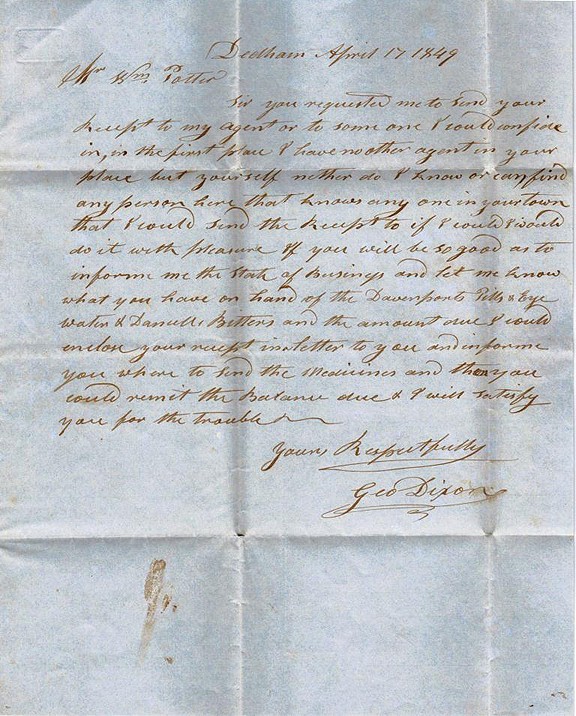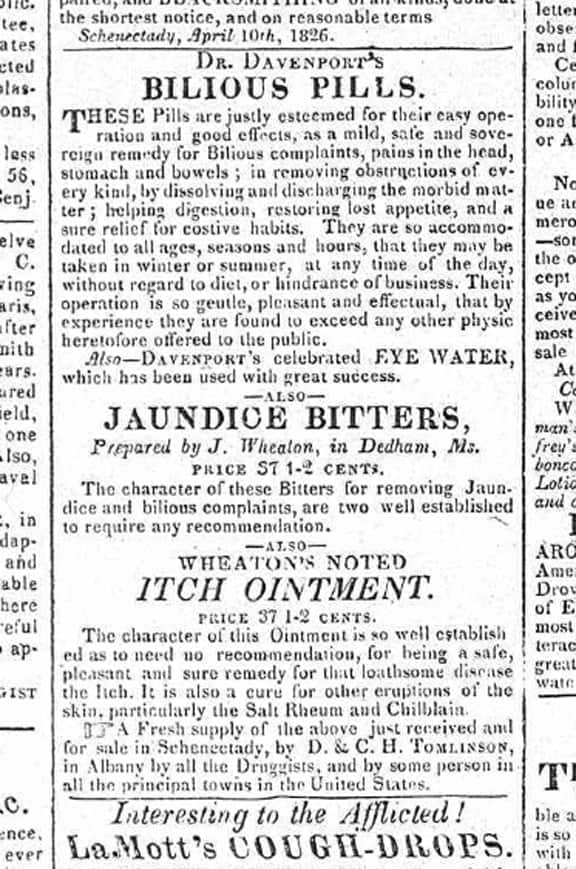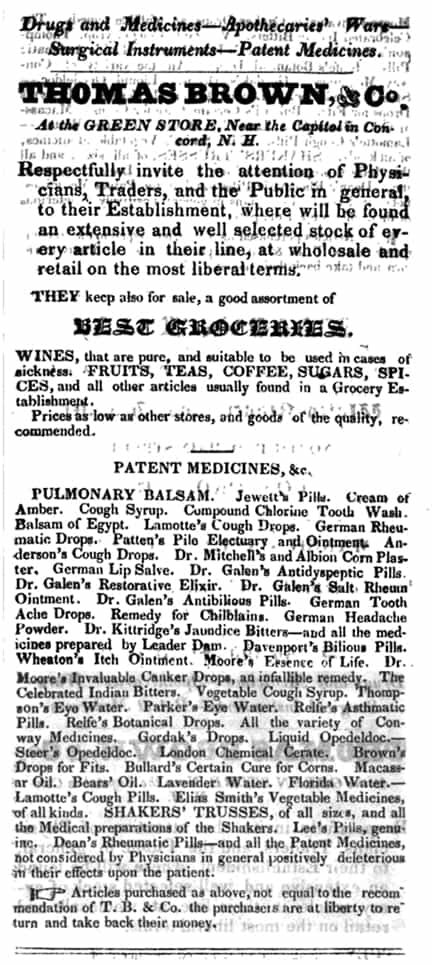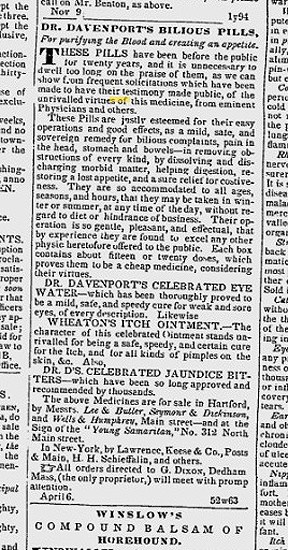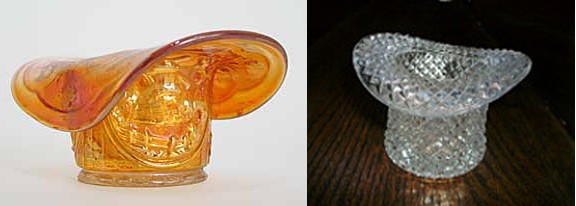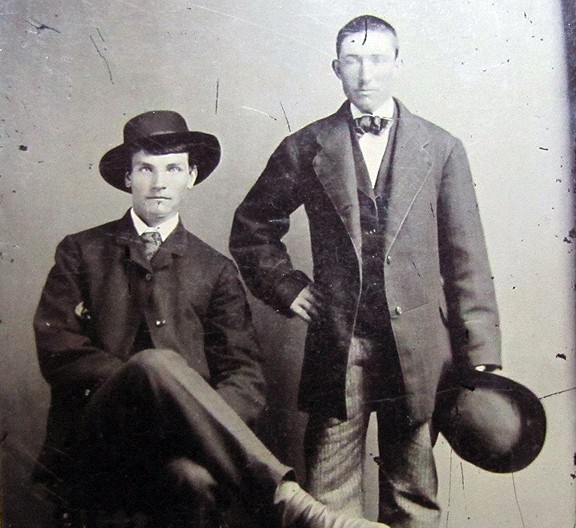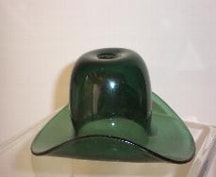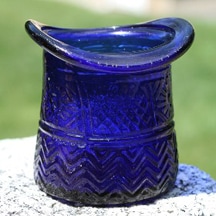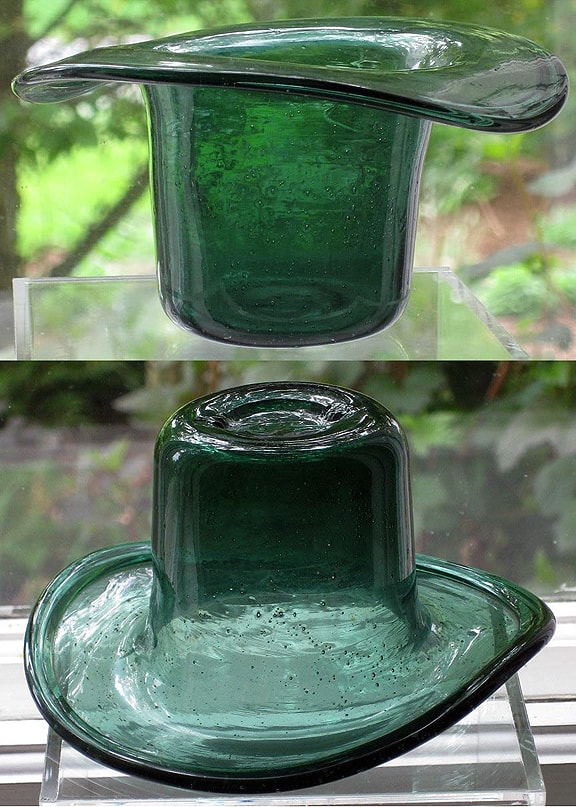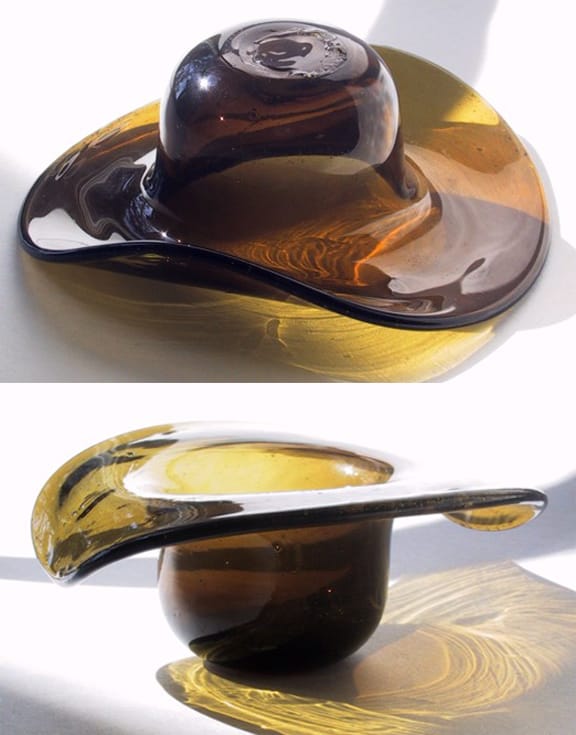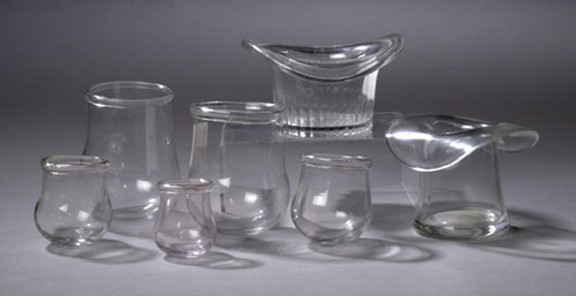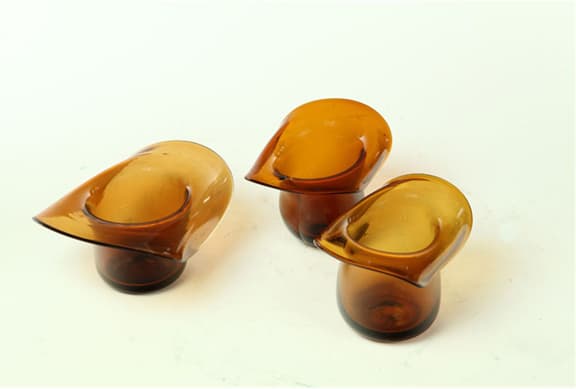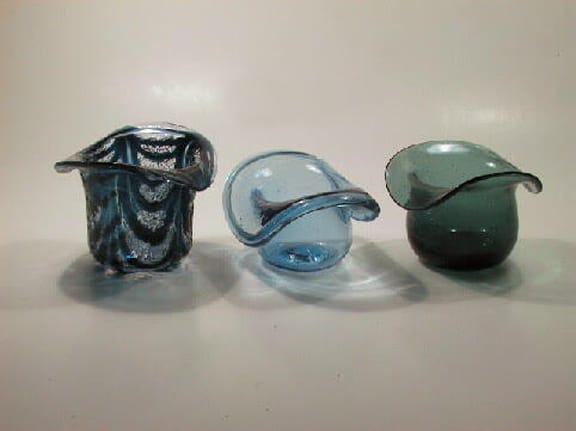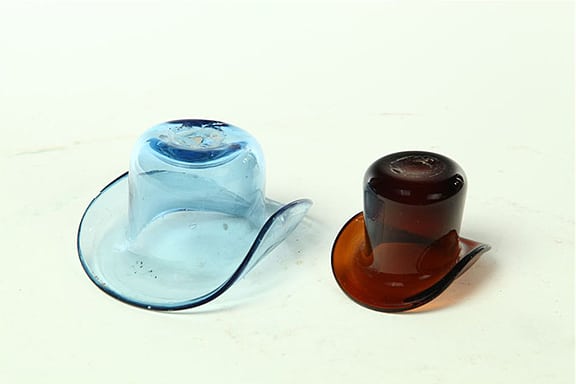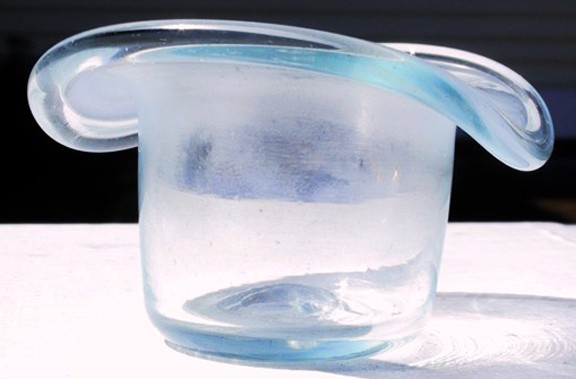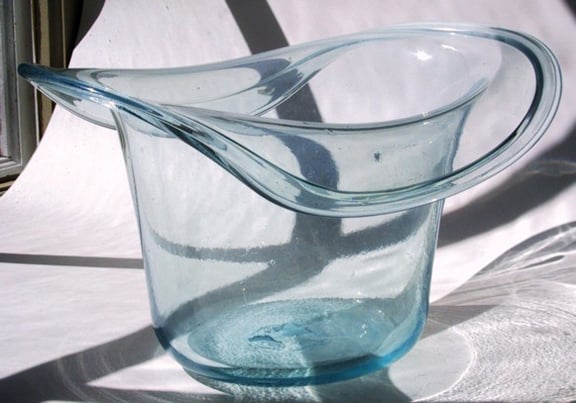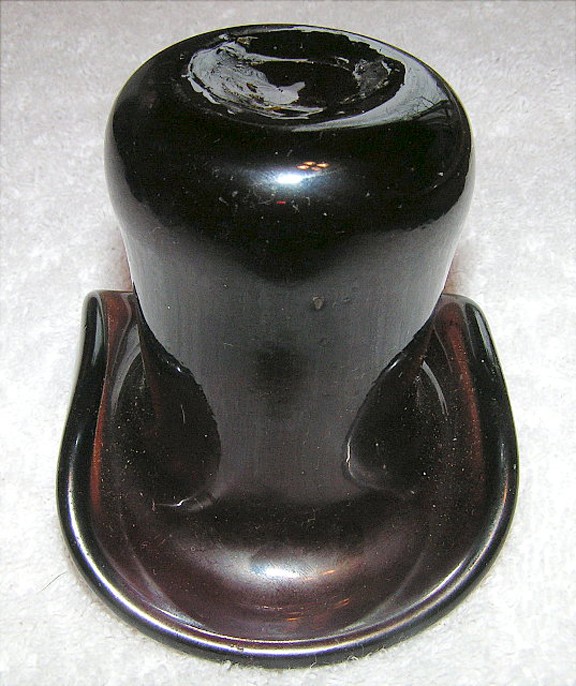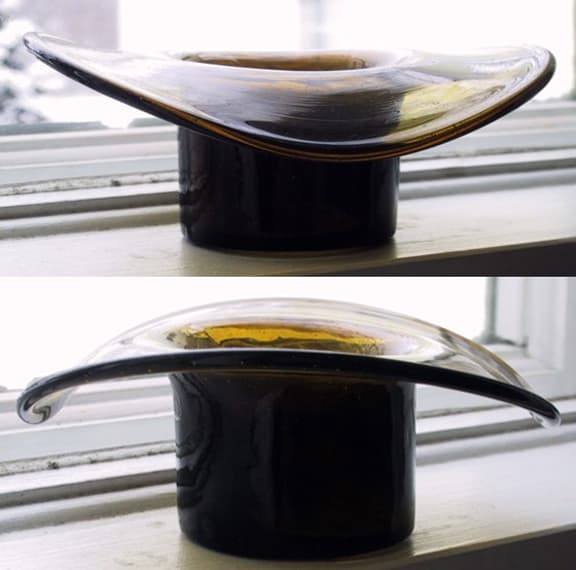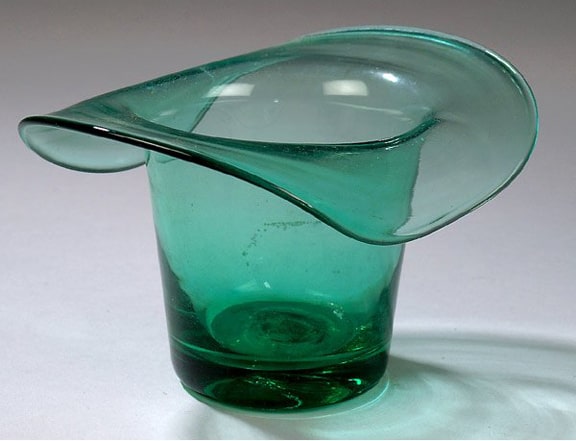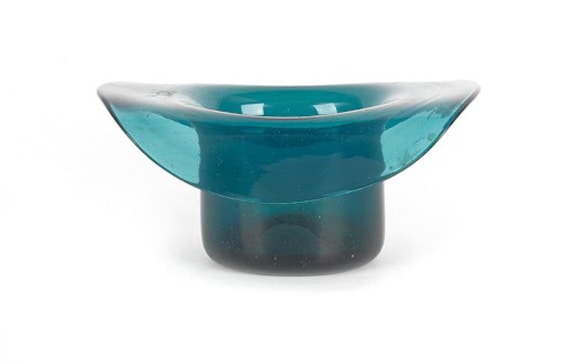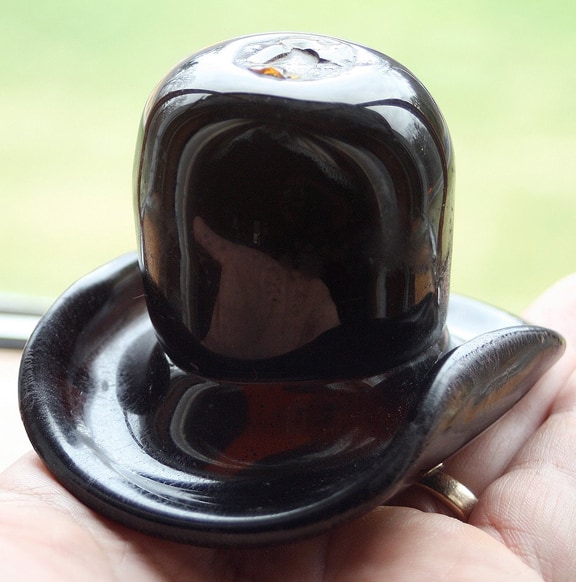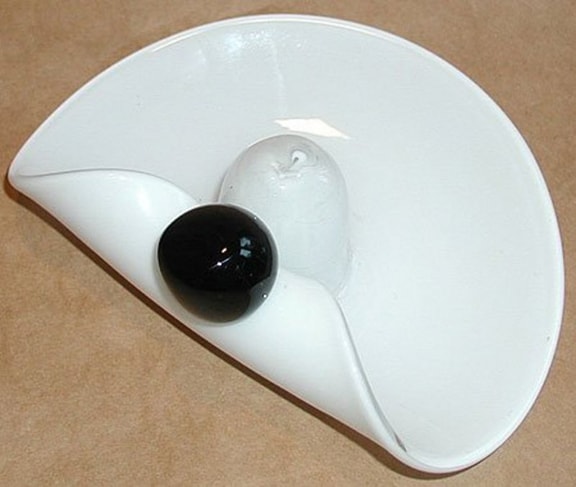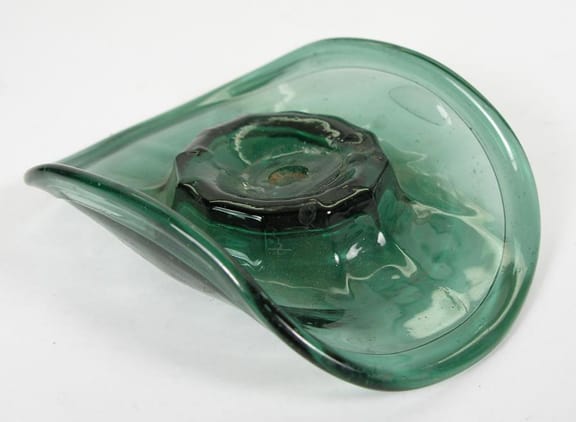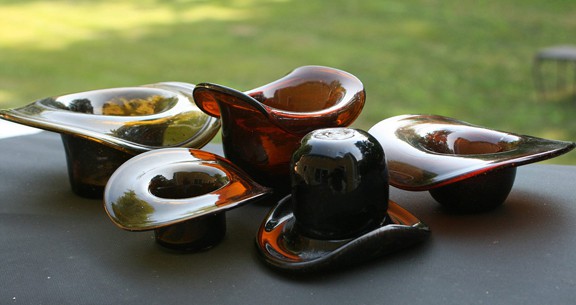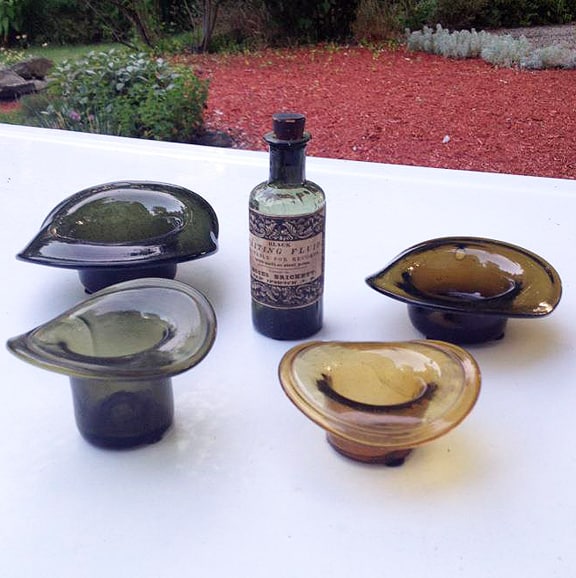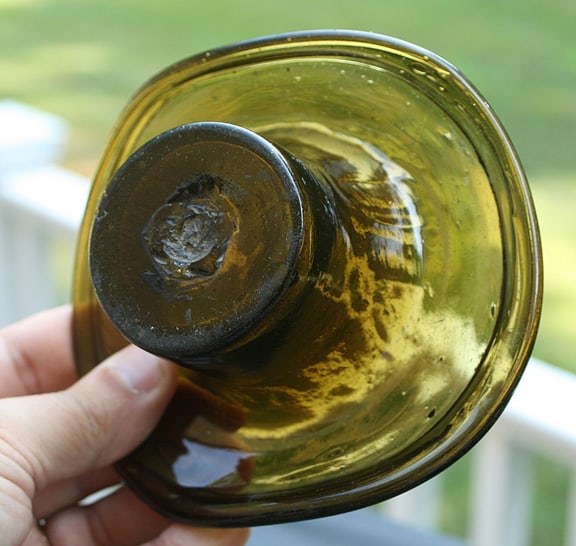Schnerr’s Wild Cherry Tonic Compound Bitters on eBay
24 May 2012 (R•041117)
 Watching this oddball on eBay. I cleaned the pictures up as the background was a bit competitive with the nice bottle. With about 1 day left in the bidding, the bottle price has already surpassed the $1,000 mark. I bet the west coast guys are on this with the Sacramento city location.
Watching this oddball on eBay. I cleaned the pictures up as the background was a bit competitive with the nice bottle. With about 1 day left in the bidding, the bottle price has already surpassed the $1,000 mark. I bet the west coast guys are on this with the Sacramento city location.

[eBay description]
Very likely a “one of a kind” bottle. Very Rare, C. Schnerr’s Wild Cherry Tonic Compound on a “recycled J. Hostetter’s stomach bitters bottle”. That’s right the front of this bottle is labeled while the back is a re-used Hostetter’s bottle. I have never seen another one like it!!. Bottle is sealed with contents still inside. Bottle has no chips or cracks and is a beautiful rare example of bitters bottle and their multiple uses. A real gem!! C. Schnerr’s MFG Chemists of Sacramento, California.

Schnerr’s Wild Cherry Tonic Compound Bitters – front label side – eBay
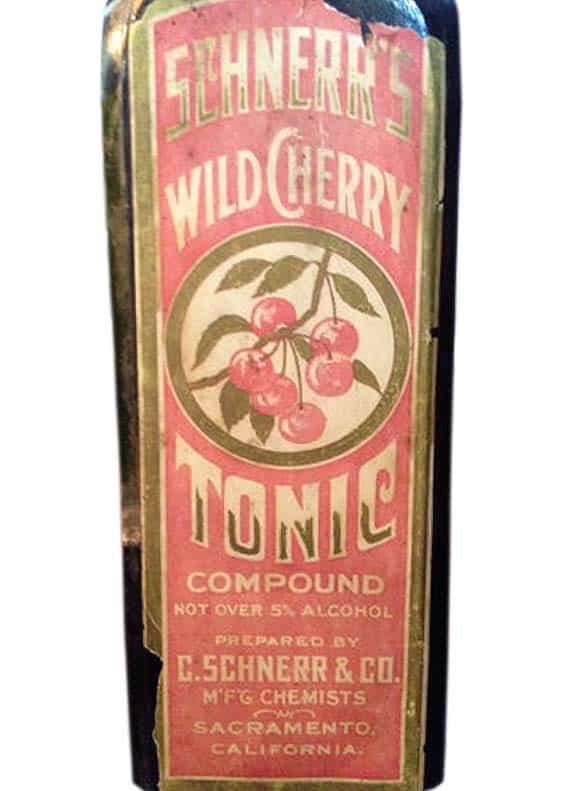
Schnerr’s Wild Cherry Tonic Compound Bitters – front label detail – eBay
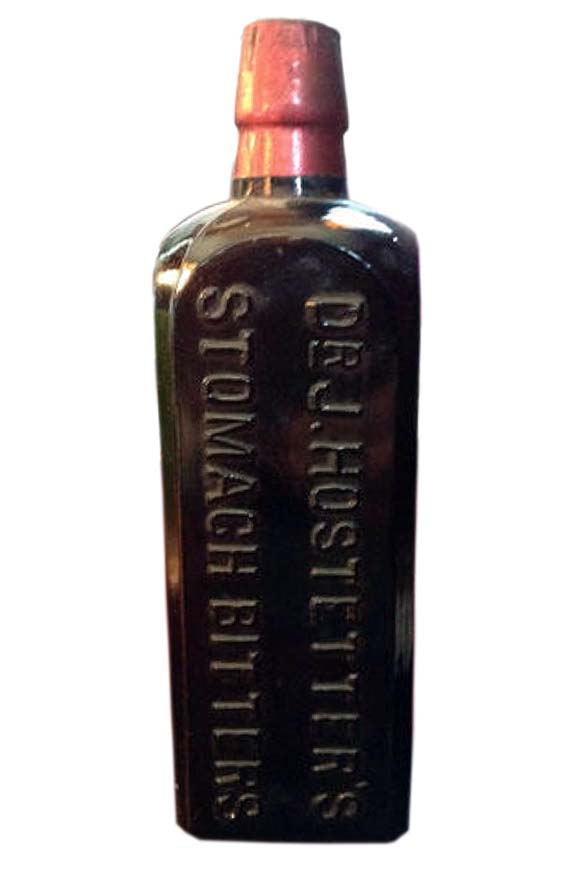
Schnerr’s Wild Cherry Tonic Compound Bitters – HOSTETTER’S STOMACH BITTERS embossed side side – eBay
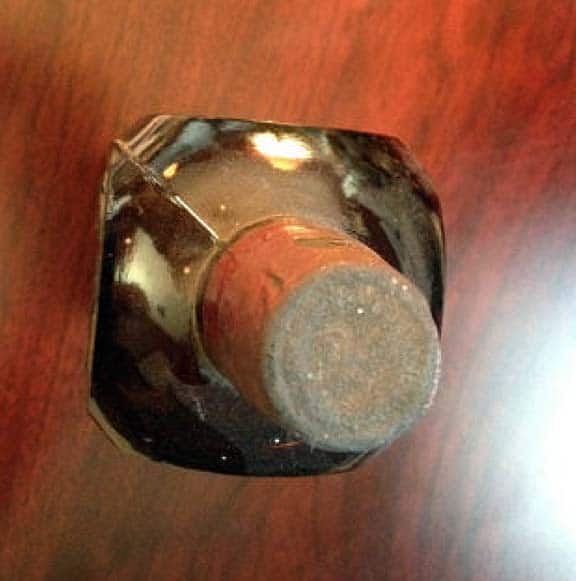
Schnerr’s Wild Cherry Tonic Compound Bitters – top view – eBay
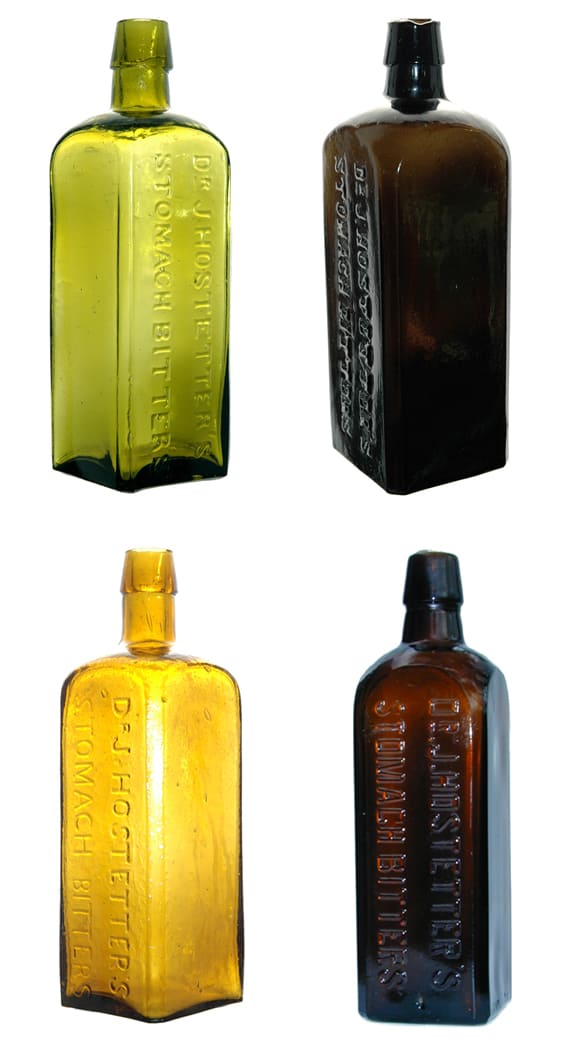
Examples of different HOSTETTER’S STOMACH BITTERS – Meyer Collection
07 April 2017 (from Carol Guida)
Hi – I saw your post about the Schnerr’s Cherry Tonic bottle that sold on eBay. I am from California an stumbled upon a lot of information on the Schnerr Bottling Company while I was doing some research on the Carpenter Hotel (circa 1900) at Emigrant Gap. As far as I know, the hotel is no longer standing – but the owners of that hotel and the Emigrant Gap Hotel had a business and personal relationship with the owners of the Schnerr Company. I am wondering if the bottle was so expensive due to the scandals that surrounded the Schnerrs? I captured some of the Schnerr scandal and here is what I know (PS: I am a Sierra History buff and not a bottle collector but thought you might be interested in this history. Also – there is a lot of information here so at the end, I put in a short timeline):
THE CARPENTERS AND EMIGRANT GAP
The Carpenter Hotel was built by William Carpenter. William came to California 1852 and he had 740 acres of land in Emigrant Gap and 1700 acres near Truckee. He was a rancher and also had a home in Folsom area.
He died at his Folsom home in February 20, 1906 from a herromage. His daughter was Annie (see above article). His sons were William Jr. and George (see article above). William Jr. died of TB in Folsom in 1906.
Annie was married to Edward Schnerr of Sacramento on March 21 (or April 6), 1906, just one month after the death of her father and shortly after the death of her brother. Edward was 39 and Annie was 43 (a spinster). They moved into 2515 H St, Sacramento. None of William Carpenter’s children had children of their own.
Edward Schnerr lived in Sacramento and along with his brothers Antoine and Constant Jr, owned the Schnerr Bottling Company (inherited from their father in 1897). The first reference I have to the Soda Works company was before it was renamed to Schnerr. In 1890, it was called the Capital Soda Works company owned by Constant Schnerr Sr.
I recently received a copy of a receipt that shows that Schnerr and Company sold beer to the Emigrant Gap Hotel. It would be likely that his company could have been selling beer at the Carpenter Hotel as well. This could explain how Annie met Edward.
In 1907, Annie was awarded her father’s estate with property in 3 counties as the sole heir. She then deeded 1500 acres of land in Nevada County over to Mr. Cox, a friend and the administrator of her estate. The land was deeded with the understanding that she could reverse the deed at any time. She also purchased 4 additional pieces of property in Sacramento. That same year, Edward and his 2 brothers (Antoine and Constant) had their sister committed as an incompetent with a guardian placed over her. (Note: She had been committed before by her mother in 1901).
Annie died suddenly on October 29, 1908.
DIED.SCHNERR —Passed away at her late residence, 2515 H street, in this city, October 29, 1908, Anna E. Carpenter Schnerr. beloved wife of Edward Schnerr, daughter of the late William and Julia Carpenter, a native of Folsom, Cal. Friends and acquaintances are respectfully invited to attend the funeral from the family residence, 2515 H. Saturday morning at 9:30 o’clock, thence to the cathedral, where requiem high mass will be celebrated for the repose of her soul, at 10 o’clock.
Once Mr Schnerr inherited his dead wife’s family fortune (1909), He sold the house on H st to C. N. Post in November 1909.
He retired from his company (C. Schnerr and Company – Bottling Company and Soda Works) at about 43 years old in March of 1910.
Edward Schnerr remarried May 18, 1911 to a Mary Isabella Norton (19 or 20 years old to his 44), had 2 children (1912, 1913) and died in 1941. Mary was the daughter of Thomas Norton of Sacramento.
AND NOW IT GETS INTERESTING . . . .
While Annie was still alive, Edward was involved in a major scandal in February 1907 and his brother Antione involved in a divorce scandal in 1908.
Below are some of the newspaper articles about the scandals:
February 2, 1907 – Sacramento
ALLEGED BLACKMAILING SCHEME EXPOSED!
Miss Ethel Fair, Who Claims to be a Granddaughter of Late Senator, Tells Story. DR. F. STEELE UNDER ARREST
For the alleged threat to kill Miss Ethel Fair, who says she Is a granddaughter of the late Senator James G. Fair [NOTE: If she was she would have been an illegitimate daughter of Charles Lewis Fair – the senators scoundrel of a son], and who lives at 1016 ‘Twentyeighth street in this city, because she would not enter into his scheme to blackmail prominent business man of Sacramento and a respected woman, Dr. Fred Steele and his brother, Charles Steele, are in the city jail.
According to the story told by Miss Fair, Dr. Fred Steele, who has offices on K street, alone approached her with the blackmail proposition. Several months ago the brothers, Dr. Fred Steele and Charles Steele, according to the information gathered by the police and the city attorney, came to this city and represented themselves to be fortune-tellers and clairevoyants. They took office rooms and started out to forecast future events and made such good headway that they moved into the business section and started an office, the State Medical on K street, near Sixth.
Soon after the change in location, Miss Fair went to the offices to have her fortune told. Miss Fair, according to the story as told by her to the police, went to consult the doctor about certain litigation in the Fair estate, in which she Is interested. Dr. Fred Steele “told her fortune,” but omitted any mention of the litigation, saying he would tell her some other time, as he wanted to consult the spirits again. Accordingly, Miss Fair departed and a few days later called again to hear what the spirits had revealed to the clairvoyant, but on this occasion and many others during succeeding weeks he put her off with the same old excuse, that the spirits refused to “come through.”
Finally they received her answer, she says, but it was unsatisfactory, and to appease and placate her for the bad news, Dr. Steele told her be would secure for her a position In one of the local stores, where she would be able to earn her living and to live comfortably.
The same old story was handed out whenever she appeared in the office until last Sunday, when, she says, Dr. Steele made known to her the work he intended her to do.
Alleged Blackmail Scheme, His first scheme, the girl says, was to secure $15,000 from Edward Schnerr, a wealthy merchant. According to the programme, Miss Fair was to play the part of Dr. Fred Steele’s wife and then attract Mr. Schnerr’s attention and make arrangements to inveigle him into a lodging-house. The dummy husband was to appear in the room and by bluffing, and with the aid of Constable Tim Hagerty, secure $15,000 from Schnerrin order to keep the scandal quiet. Incidentally Hagerty, who Is well known In this city, solemnly and it is believed truthfully declares that he never heard of such a thing.
The next turn in the blackmailing line. Miss Fair told the police, was to be directed against Mrs. Perkins of this city. It was proposed with the aid of Miss Fair and the officer to get Mrs. Perkins into a compromising or embarrassing position and demand $l8,OOO to squelch the affair. Still Another Story. This was not all. After they should , have divided the proceeds equally in both cases, Dr. Steele and Miss Fair were to go to Los Angeles, where she said he knew a wealthy landowner. This time Miss Fair said she was booked to marry the millionaire, and Dr. Steele was to give her a slow poison to administer to the husband, and after his death, which would be accomplished within a few months with no evidence of the poison, the fortune was to be divided and Dr. Steele would disappear and Miss Fair could live on in the southern city in comfort and with a big fortune at her command. To all of these overtures couched, the woman says, in alluring language and with the temptation of positive security, she made emphatic refusal.
Then it was that Dr. Steele is alleged to have made the threat to kill her if she should tell of the schemes he had proposed. He took a revolver out of a side drawer, she said, and showing It to her said he would not only blow out her bralns, but kill Edward Schnerr as well. This all occurred, the woman explained, last Sunday in Dr. Steele’s office, and she left the place with his threat ringing in her ears. She told the police she worried about the threat and the blackmail scheme in which It was proposed to get the money from Mr. Schnerr. After two days’ study over it she decided to tell Schnerr of the proposal Dr. Steele made to her, and to put him on his guard against any such attempt.
When Mr. Schnerr had heard the startling story of the scheme to fleece him out of a small fortune he went to Chief of Police Denny and reported. Detectives Pennish and Ryan were detailed on the case, and after an Investigation arrested the Steele brothers, but have placed a charge against only Dr. Fred Steele.
Deplores Publicity. Miss Fair deplores the fact that the case has been taken to the courts, as she. In telling Mr. Schnerr, only wished to put him on his guard. She tells the story straight and said yesterday to the police that Dr. Steele told her the game was easy to turn, as he, with the help of another woman, fleeced a certain young doctor of this city out of $5000. The woman, he said, left for the east soon after the fleecing operation and she had $2500 in her purse as her share in the job. He told her there was no trouble in doing the work and it was perfectly secure, as he is too foxy to be caught. According to Miss Fair’s story, told to the police in the presence of Dr. Steele, he told her that Sacramento offered a fine field for such business and they could “skin*’ a large number here this winter. All she would have to do was to follow his instructions and then receive her portion of the spoils.
Steele’s Sweeping Denial. Dr. Fred Steele makes a sweeping denial of the whole affair, saying Miss Fair had been persecuting him for several months and when she left his office last Sunday she said she would have revenge for an insult he had offered her. His brother, Charles Steele, was released from custody yesterday, as Miss Fair said he was In no way, as far as she knows, connected in the proposed blackmailing scheme. The case came up In the city Justice’s court yesterday morning and was I continued until today on account of j the desire of City Attorney Howe to make a further investigation and secure some witnesses. The case as it stands at present consists of the startling accusations of Miss Fair and the sweeping denial Dr. Fred Steele. It will be up in the city court again today when Miss Fair will tell her story. She promises to tell all she knows and will not mince any of the details of the alleged transaction. She did not take part in having the matter investigated, but says now that it has gone this far . She will stand by her story told to the police. On the other hand. Dr. Steele promises to make a few startling on the line that the whole affair is the result of a desire for revenge on the part of Miss Ethel Fair.
February 5
MISS FAIR MAKES MODEL WITNESS Tells Again the Story of Dr. Fred Steele’s Alleged Threats —Courtroom Crowded and Case Continued,
The examination of Dr. Fred Steele was resumed in the city justice’s court yesterday. The courtroom was crowded to suffocation, and when the continuance for the day was taken at 5 o’clock the crowd had heard what it came to hear and went away satisfied, for Miss Ethel Fair told again and agrain under examination by the attorneys her story of how Dr. Steele made threats to take her life. The spectators did not come to the justice’s court to hear of the threats agalnst the life of Miss Fair, but did wanted to hear something about the proposal she alleges Dr. Steele made for blackmailing Edward Schnerr and Mrs. Perkins. Without a single hesitation or deviation from the story told by her as it appeared in The Union several days ago Miss Fair told her side of the case. At adjournment time the prosecution rested, having presented only one witness in support of its serious charges. Then the defendant, Dr. Steele, took the stand, but did not testify for the hour was growing late and he will be given a chance to place his version of the trouble before the court next Wednesday morning. The attorneys for the defense promise to place five witnesses on the stand. Some of these, It is said, will prove the good character of Dr. Fred Steele, while others, it Is said, will be put on for the purpose of discrediting the story told by Miss Ethel Fair.
An effort was made yesterday by Dr. Steele’s attorney to wring from Miss Fair all that happened on the occasion when she alleges Dr. Steele asked her to take part in the blackmailing scheme to get $15,000 from Edward Schnerr and $l8,000 from Mrs. Charles Perkins, but she stuck to her text and refused telling anything other than what directly applied to the charges she makes. At the conclusion of the case, as presented by the prosecution. Dr. Steele, through his attorney, moved for dismissal of the charge. This was refused by City Justice March and the defense will place its witnesses on the stand tomorrow. Dr. Steele promises a sensation when he has a chance to tell his story and hints that the startling exposures made by Miss Fair will sink tnto insignificance.
February 7. 1907
ETHEL FAIR NOT IN COURT Examination of Dr, Steeie on Charge of Threats to Take Life Concluded and Taken Under Advisement,
The preliminary examination of Dr. Fred Steele, who is charged by Miss Ethel Fair, who claims to be a granddaughter of the late Senator Fair, with threats against her life, was concluded in the clty justice’s court yesterday afternoon, and Justice March took the matter under advisement until next Monday morning at 10 o’clock. The principal witness yesterday was Charles Steele, clairvoyant and half-brother of the defendant. Charles Steele, under direct and cross-examination, told his version of the alleged threats against the life of Miss Fair, and also said that the charges that his brother had made proposals whereby Miss Fair was to enter into blackmailing schemes against Edward Schnerr and Mrs. Charles Perkins were false. He claims he was In the adjoining office two weeks ago when Miss Fair alleges Dr. Steele made the proposals and threats, and that ho did not hear a word of such proposals or threats. He went even further and testified that had anything of the kind been broached to Miss Fair by his brother he would have heard it. The witness occupied the stand during a greater part of the forenoon and for an hour in the afternoon session. Thls testimony was to the same effect as that given last Monday by Dr. Fred Steele, and consisted of a sweeping denial of all the charges. Several character witnesses were called on behalf of the defendant, but in most of the cases they failed in that role and were led to admit that they did not know anything about Dr. Steele’s reputation. George Bock and James Shlnkle said they had known Dr. Steele for several months, and always found him to be a gentleman, but had never heard his reputation discussed.
Constable Tim Hagerty was placed on the stand by the defense for the purpose of disproving that part of the story told by Miss Fair in which she said he was to enter into the blackmailing scheme to force Edward Schnerr to pay $15,000. Constable Hagerty said he had met Dr. Steele only a few times and all the reports that he and Dr. Steele had entered into an agreement to fleece Edward Schnerr were false. While his evidence was not material and had no hearing on the being held in the court, it was allowed for the purpose of clearing up the matter in connection with the alleged blackmailing programme. As was the case in the first two days of the examination, the courtroom was crowded to overflowing, not even standing-room remaining.
Nothing of a sensational nature was adduced, and the complaining witness, Miss Fair, was not in the courtroom, although she was waiting In the city attorney’s office. She appeared at the. city court unattended and quietly went to the inside office to wait for a call if wanted to take the witness stand. Those in attendance at the trial were unaware of her presence, and at the conclusion of the examination she departed as quietly a.s she came. Before leaving .she stepped into the courtroom and asked if it would be necessary for her to appear next Monday, and said: ‘‘My, I am awful glad this is all over, and I do hope he will not bother me any more.” She seemed to be laboring under suppressed excitement, until assured that no barm would come to her.
February 9 1907
DR STEELE HELD IN $500.00 BONDS City Justice March Felt the Story Told by Miss Ethel Fair That Her Life Was Threatened Was True.
To protect Miss Ethel from the threats against her life made by Dr. Fred A. Steele, the latter was yesterday placed under $5O0 bonds to keep the peace for six months, and in passing the judgment City Justice March warned Dr. Steele not to molest or bother Miss Fair in any way on penalty of the forfeiture of the bonds. Yesterday afternoon Steele had not provided the bonds, but his cash bail jof $500 was still In possession of the court clerk and will be so held until he provides bonds.
The trial of Dr. Fred A. Steele was held in the city justice’s court last week, and Miss Ethel Fair alleged that he had made threats to kill her if she told anyone of several blackmail schemes he proposed to have enter with him. It will be remembered that at the hearing Miss Pair said that one I Sunday afternoon while In Dr. Steele’s office he proposed that she play the part of his wife and then go out and make arrangements to meet Edward Schnerr, a wealthy merchant, in a lodging-house. The plan, she said, was to have Dr. Steele appear on the at the proper time. He was to represent a badly wronged man and to assuage his wounded feelings and the breaking up of his family the victim (Mr. Schnerr to be asked to provide salve to the tune of $15,000. (After this trick should have been turned), the girl said Dr. Steele assured her they could weave a tangle about Mrs. Perkins and secure $18,000 from her in order to keep a bogus scandal quiet. To all of these proposals Miss Pair said she would not listen and refused to have anything to do with them. She left the office In a rage and subsequently told the story to Mr. Schnerr. She said she told Dr. Steele what she was going to do he took a pistol from a drawer and threatened to kill her, and said he would also kill Mr Schnerr if she told him. Mr. Schnerr took the matter to the police and Dr. Steele’s arrest followed. In passing judgment City Justice March said he believed every word the prosecuting witness (Miss Fair) had said on the stand, but he was not prepared to say whether Dr. Steele had made the threats in a jest or really meant them.
I have not been able to find out anything else about what happened with the scandal, Mr. Steele or Ms. Fair except that if Miss Fair was the granddaughter of James G Fair, she would have been the illegitimate daughter of either James G Fair Jr who drank himself to death in 1892 or of Charles L Fair and Caroline Dexter Smith (aka Maud Nelson. Maud Ulman, Maud Thomas), a women of questionable repute who worked at a men’s resort in San Francisco before her marriage Charles and his wife were killed in a car accident in France in 1902.
ANTOINE’S SCANDAL
October 18, 1908
S. SCHNERR’S SIDE OF STORY Says She Is Victim of Conspiracy, and That Charges Are False, October 18 1908
Mrs. Alene Schnerr, wife of Antoine Schnerr,gives out the following statement: I “The charges of infidelity in the complaint of my husband are absolutely untrue and unfounded, and no one knows this better than my husband, and, when the case comes to trial, I will prove beyond all doubt that the said charges are unfounded; and further, that they were brought as a result of conspiracy on the part of my husband and his relatives to obtain possession of my separate property, and force me into relinquishing all claim to the same.
“I have placed my case in the hands of Messrs. Devlin & Devlin, my attorneys, and they have brought for me a suit for divorce against my husband based upon extreme cruelty. Doubtless, my husband, anticipating such a suit, filed his complaint first, but that will not make any difference, as I will prosecute the case I have , brought, and defend the case he has brought. “I have also brought a suit against him and secured an injunction from ; the superior court preventing him from assigning, transferring, or collecting certain notes and mortgages which he obtained from me by misrepresentation and fraud. “I inherited certain money from my father’s estate, and loaned out the same in my separate name, and with the interest which accumulated on said I loans, and also from other moneys of my own, made other loans, all in my own separate name.
“Last December my husband took a trip to Honolulu, and. as he was to be gone several months, he suggested ‘ to me that it would be advisable to assign the notes and mortgages to him, so that if anything should happen to me while he was gone, he would be able to secure the same without administration on my estate. He said that they would be kept in the safe deposit box to which I have access, and having full confidence and faith in my husband, I executed the i assignments referred to, but with no I other intent or purpose than that if anything should happen to me while he was gone he would be able to succeed to them without administration. “A few days ago he came to me and said that he was about to have the notes and mortgages renewed at a higher rate of interest, and that for this purpose it was necessary that I should indorse the notes over to him so as to facilitate the renewal thereof, and having faith and confidence in his statement, I indorsed the notes over to him.
Since that time I have learned that he did not intend to have the notes renewed in my name, but through the fraud and artifice that he employed, desired to have them renewed in his own name, and prevent me from enjoying my separate estate and property. “As soon as he accomplished his purpose of having all my property In his hands, he brought the suit for divorce, endeavoring to intimidate me. so that I would not seek to have my property returned.
“I do not intend to let him profit by the fraud and artifice which he has employed, but have brought suit to recover the possession of the notes and mortgages, and, as stated above, an injunction has been issued to prevent him from transferring or collecting the same, and all the parties who are indebted to me have been notified not to pay him.
“The basis of my complaint in the divorce is extreme cruelty.
“Last Thursday morning I was on Seventh street with a lady friend, when my husband and his brother,Edward Schnerr approached us and created a scene on the street in which I and my name were as viciously attacked by my husband and said Edward Schnerr, and they both threatened to drag me down; but I intend to have my good name sustained, get my legal rights, and have all my property restored.
Antoine’s wife won her suit for divorce in December 9 1908. I do not have her maiden name, so I do not know what happened to her after her divorce in October 1908.
In 1911, Antoine remarried Verda Simmons in Sacramento in 1911 (19 years old to his 37) and moved with her to Hawaii (he was bottling dairy cream at the time to ship from California to Hawaii). Antoine is buried in Hawaii though Verda does not have a death date on the gravestone.
In February 1908, the Schnerr bottling company got in trouble with the law for labeling beer bottles as soda bottles and selling them to an unlicensed hall. Here is the story:
BEER AT ART BOTTLED HERE Chief Sullivan Finds Dance Brand Is Put Up in Sacramento.The beer sold without a license over the bar at the Art dance hall bv Dick McCreadie and Joe Sullivan was bottled but not brewed in this city. Chief of Police Sullivan stated yesterday that he has information that the liquor was bottled at the Schnerr place, K street, Third and Fourth, and was put up by order of Dick McCreadie. The beer, he said. Was brewed by the Fredericksburg company. In order to deceive the police and the people the beer was bottled in soda water bottles, W’hlch were not labeled or marked In any way. The ice chest, in which the police found the beer, when they arrested McCreadie and Sullivan last Saturday night, also contained soda water bottled In the same kind of bottles. Chief of Police Sullivan has samples of both in his possession and he will use them as evidence when the case comes to trial in the city justice’s court.
After Edward Schnerr was awarded Annie’ estate, he filed a claim against Mr Cox to regain the 1500 or 2300 acres of property. He also sold off the property that Annie had purchased in Sacramento. He put the Carpenter Hotel up for a long term lease (Offered 1910, leased in 1912). Mr. Schnerr won the case against Mr. Cox in December of 1910.
In June of 1911, Schnerr Bottling Company (under the management of Constant Schnerr Jr) went under and was sold by it’s creditors.
Timeline.
1892 George Carpenter is murdered in Emigrant Gap (see murder most foul above)
1897 The Schnerr Brothers take over their father Constant Sr bottling company business
1903 The Schnerr Brothers mother dies
1904 William Carpenter’s wife dies of pneumonia
1906 William Carpenter dies suddenly of a hemorrhage
1906 William Carpenter Jr. dies suddenly of tuberculosis
1906 Annie Carpenter sole heir and spinster marries Edward Schnerr
1907 Annie inherits her family estate, buys property in Sacramento, deeds large property to estate executor with the condition that she can recall the deed an any time. The Carpenter Hotel is put up for lease.
1907 Edward gets involved in a major entrapment scandal where entrapment and poisoning is mentioned
1907 Edwards sister committed as an incompetent
1908 Mid October – Antoine gets involved in a divorce scandal over wife’s inherited property, Edward and Antione verbally attack Antione’s wife and the wife wins case
1908 Late October – Annie dies suddenly of an apparent heart attack, Edward discovers body
1909 Edward inherits Carpenter estate
1909 Edward sells Sacramento property
1910 Edward files case against executor deed and wins
1910 Edward retires, stating he has no responsibility or claims for Schnerr Bottling
1910 Edward again puts hotel up for long term lease
1911 Edward remarries 19+ year old in Sacramento
1911 Antione remarries 19 year old and moves to Hawaii
1911 Schnerr Bottling company gets sold by creditors
1912 Edward finds group to lease Carpenter Hotel at Emigrant Gap
1912 Edward has moved to San Francisco and Moss Beach and has first child
![]() An interesting bottle closes on eBay today. This is an extraordinary example of a C. A. RICHARDS 99 WASHINGTON ST. BOSTON square. I believe it is a Bitters though there is thought that is is a Whiskey too. I first saw a C.A. RICHARDS on eBay a year or so ago. It seemed like it stayed up there forever. I suspect the example never sold and was moved to American Glass Gallery. If not, the amber example that just closed on AGG was the third example to pop up recently.
An interesting bottle closes on eBay today. This is an extraordinary example of a C. A. RICHARDS 99 WASHINGTON ST. BOSTON square. I believe it is a Bitters though there is thought that is is a Whiskey too. I first saw a C.A. RICHARDS on eBay a year or so ago. It seemed like it stayed up there forever. I suspect the example never sold and was moved to American Glass Gallery. If not, the amber example that just closed on AGG was the third example to pop up recently.